RELATED LINKS
On this page, fare zone maps (pdf), public transport london, fares & payments, london airport transfers, cruise port transfers, travel to / from london, most popular tours.

- Guide to hotel areas
- Bed & breakfast
- Backpacker hostels
- Airbnb London
- Central London tours
- Tours from London
- Hop-on hop-off bus tours
- Harry Potter tours
- Stonehenge tours
- Downton Abbey tours
- Windsor tours
- Cotswolds tours
- Private tours
- Ticket & pass offers
- Central London attractions
- Attractions outside London
- Harry Potter attractions
- Tower of London
- PUBLIC TRANSPORT
- London City
- London Southend
- Southampton

London Travelcard v Oyster Card v Contactless card in 2024
Make an informed choice on the right london travel pass for you.
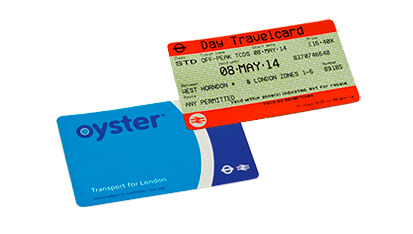
For the visitor to London, the question of which travel pass to purchase can be confusing. Those living and working in London will almost always have an Oyster Card in their wallet and, as a general rule of thumb, the Oyster Card is the benchmark to be beaten, although people are fast migrating to contactless payment cards.
Many will have a long-term travel pass attached to the Oyster, and these can be valid for as short as a week or as long as a year.
Buying a single ticket for one journey is rare, you are penalised very heavily financially. A one-way single ticket on the Underground in Central London is double that of an Oyster fare and not far off the maximum you can pay in a day of unlimited rides using Oyster.
Where to use Where to buy Visitor Oyster Returning the card Cheapest option Price caps Fares Concessions Group tickets Child fares

On the buses buying a one-way ticket is just not an option offered.
The Contactless payment card is the newest option available along with mobile payments and the authorities hope this will become the dominant channel in the longer term. However for short-term visitors the adoption rate is far less and for good reason, especially if you are from overseas and do not have a British sterling or pound currency credit/debit card.
For the tourist or those making short visits to London there are aspects of the Travelcard that make them appealing and if understood can make Travelcards cheaper than Oyster cards or Contactless payment cards, especially if you are visiting the major sights on a first time visit.
So all in all it can be quite confusing for the visitor planning their visit to London to make an informed choice.
This page discusses the differences between Oyster, Contactless Payment Cards and Travelcards so you can identify the right product for you. Our detailed Travelcard , Contactless payment cards and Oyster card pages give a full explanation of each.
Where you can use London travel options
All three options, Oyster card, Contactless payment card and Travelcards cover the same London public transport, with the exception of Gatwick Airport (see below):
- The London Underground network.
- The London red local bus network.
- The railway network in Greater London.
- Docklands Light Railway, TfL Rail and Overground Railway.
- Heathrow Express
- Discount on many scheduled river services (though not Contactless payment card and fragmented implementation on Oyster/Travelcard).
Using Oyster and Travelcards on the Heathrow Express and other Heathrow services
From 19 February 2019, Oyster cards, contactless bank cards and mobile devices are accepted on the Heathrow Express. This will speed up the process of ticketing for this train for customers who can now enter with just a tap of your card on the ticket barrier. Prices are the same as buying your ticket at the station, with a single peak charged at £25 and off peak £22. You can save money by booking your tickets online in advance or in advance using the Heathrow Express app. Children aged 15 and under can use a Zip Oyster card to travel free on the service.
You can also use Travelcards on the London Underground and TFL Rail train services to Heathrow.
Using Oyster and Travelcards to and from Gatwick Airport
You can use Oyster or Contactless payment cards on the trains to/from Gatwick Airport but it may well be cheaper to buy tickets from the railways instead. You cannot use Travelcards to/from Gatwick Airport and it may be cheaper to travel using rail tickets between Gatwick and London than using Oyster.
Stansted, Southend, Luton airports and City Airport and London's public transport system
Stansted , Southend and Luton airports are outside London and beyond the scope of London public transport or TfL, so the airport buses and trains from these airports are not covered.
City Airport is serviced by the Docklands Light Railway (DLR) and is covered.

Differences in ease of purchase/charges
Both Oyster and Travelcard can be purchased on demand from Underground stations, Visitor Centres and literally hundreds of retail outlets, such as newsagents and convenience stores inside London.
There are few places outside London you can purchase them. Note at Underground and DLR stations there are no manned ticket desks, just ticket machines.
You can purchase Oyster cards and Travelcards online from the TfL online shop (banner link below) and have them delivered to your home address wherever in the world.
Oyster cards you purchase in this way are Visitor Oyster cards, the differences are explained further down the page.
Please note: Contactless payment cards are your normal personal credit/debit cards, so as long as your cards support the Contactless payment technology then you don't have to do anything. You just use your credit/debit card as an Oyster card.
Deposits & admin charges
When you buy a Visitor Oyster card you pay an activation fee (currently £5) which is not refundable. For standard Oyster cards purchased in London you pay a £7 deposit which is refundable (see Oyster v Visitor Oyster section below).
For short-term visitors, contactless payment cards and Travelcards are the only travel passes where you do not incur the deposit/admin charges of Oyster purchase.
Oyster Card v Visitor Oyster Card
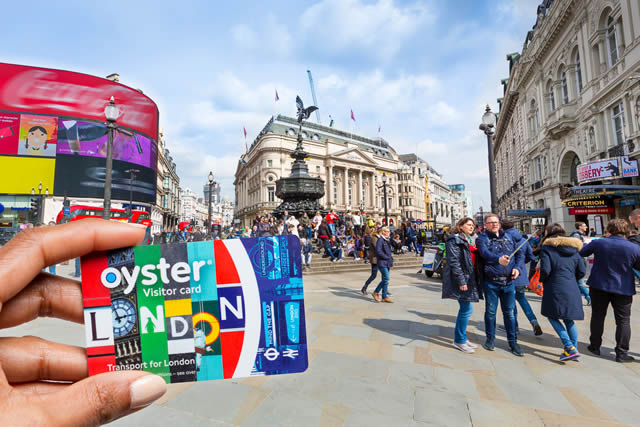
There are two types of Oyster card. If you buy in London you get the standard Oyster card. If you buy outside London, including airport trains and National Express coaches, overseas agents and online you will get a Visitor Oyster card.
Oyster & Visitor Oyster card differences - key facts
Oyster fares and caps are the same whether you use a standard Oyster or a Visitor Oyster, a common misconception.
For Visitor Oyster cards you pay an activation fee (£5 in 2024) which is non refundable. If you buy an Oyster card in London you pay £7 in 2024.
You cannot load 7 day Travelcards on Visitor Oyster cards only standard Oyster cards. If you are in London for 5 plus days having a 7 day Travelcard loaded on your Oyster can save you significant cash. For 5 days daily travel in London, Oysters and 7 day Travelcards for most visitors will be almost identical in price. For 6 or 7 days the sixth and seventh days are effectively free for a 7 day Travelcard compared to the Oyster total price.
At the end of your trip both Visitor Oyster cards and standard Oyster cards you can cancel at ticket machines and get any cash left on the Oyster refunded (in cash/coins).
For a standard Oyster card you can, if you wish, register online. With Visitor Oyster cards you cannot. The main advantages of being registered online is that if you lose your Oyster you can stop its use, you can get a good audit trail of your journeys and you can request a refund of cash left on your Oyster online direct into your bank account.
Visitor Oyster cards have “special offers” made available to purchasers, normally discounts on anything from food to theatre tickets relevant to visitors. Whether you would make use of any of these offers is another thing and the specifics of offers are often not clear.

BUY VISITOR OYSTER CARD & TRAVELCARD FOR LONDON
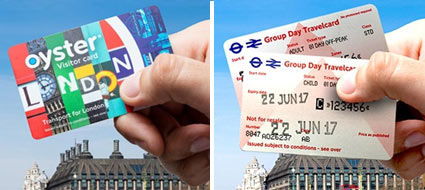
Visiting London? Save time and money on London public transport
• Visitor Oyster Card • Travelcard for 1 day anytime / off-peak or 7 days anytime • Group day travelcards available
Returning your Oyster card at end of trip
If you plan on returning to London at some time in the future then you can retain your Oyster and use it again on your return, however far in the future.
If you do not intend to return for some time or at all, you can claim back any unspent amounts on the Oyster. You can no longer claim back the deposit paid when you purchased the Oyster in the first place. You can claim back unspent funds using any ticket machine. The machine will return any unspent money on your Oyster.
If you forget to get the refund while in London you can post the Oyster card back to TFL customer services requesting the refund. For overseas visitors the big disadvantage is that the refund will be in the form of a cheque in British pounds.
This procedure is the same for both Oyster cards and Visitor Oyster cards.
Can I share Oyster cards? Do I need photo ID?
Only one person can travel with an Oyster card at any time. If 2 people are travelling together they need 2 Oyster cards. However, if you only have pay as you go credit on your card, another person can use your Oyster card when you are not travelling. If you have a Travelcard, Bus & Tram Pass or discount added to your Oyster card, you can't lend it to someone else.
No photo is required for an Oyster and your name is not stamped on the card.
You can register the Oyster card if you want but that is entirely voluntary. For concessions, principally child fares, a separate Oyster Photo ID card is often required if your child is 11 years or older and wants child fares (see bottom of the page).
No photo ID is required when you buy an Oyster card, except where children are concerned. You may well need an Oyster Photo ID card of one kind or another to access child rates. See the child concession table at the foot of this page for which one (if any) and fees.
No photo ID is required when you buy adult Travelcards from anywhere but railway stations.
For a 7 Day Travelcard or longer (adult or child) bought from a railway station ticket office (not Underground) you need to bring along a passport size photo for a rail photocard to be made up on the spot and free of charge.
7 Day Child Travelcard or longer bought from anywhere but a railway station or with TfL online shop requires an Oyster ID Card. Adults do not. See the child concession table at the foot of this page for which Oyster ID Card (if any) and fees.
Contactless payment cards - are your cards compatible?
Like all new technologies, compatibility and speed of introduction varies across the world. To make sure Contactless payment cards are even going to be an option for your credit/debit cards take a look at our Contactless payment card dedicated page linked below.
Also do remember if you are a visitor with a non-UK issued credit/debit card you'll probably be hit for foreign exchange charges by your card issuer like all other foreign purchases.
Contactless payment cards - more details
Oyster card compared with Contactless payment cards + Travelcard - which is cheapest?
As a general rule a Travelcard is more expensive than an Oyster card or Contactless payment card. The exception is if you make 3 or more journeys for 6 days or more within a 7 day period. In this case a 7 day Travelcard works out cheaper than an Oyster or Contactless payment card. Otherwise an Oyster on a Pay As You Go basis or a Contactless payment card is cheaper. If you are a resident or long-term visitor there are monthly and annual Travelcards.
You can load 7 day Travelcards onto an Oyster card and switch between Oyster Pay As You Go and Travelcard as your travel patterns change. You cannot do this on a Contactless payment card.
If you use a credit/debit card using Contactless payments whose home currency is not British pounds your card will be charged like any other overseas purchase so you should check whether you will be hit for punitive foreign exchange charges by your card issuer - there is a wide variance between different cards. The best cards have no fees.
If you have children under 16 year of age then your decision will probably be driven by access to child fares. Travelcards often give you access to child rates much easier than Oyster for short duration visits - see the getting child rates section further down this page.
Discount entitlements can't be added to a Contactless payment card. So if you are eligible for free or discounted travel, you should continue using your existing Oyster card. This in effect rules out children using Contactless payment methods.
If you are doing the sights in London like the Tower of London. London Eye, Madame Tussauds etc. then you really should read about the 2 for 1 admission promotion which Travelcards can qualify you for, but Oyster cards do not.
Oyster v Contactless payment cards v Travelcard peak & off peak travel - the differences
Price caps apply to Oyster cards and Contactless payment cards. A price cap is the maximum you can pay in any one calendar day (see next section down).
The 1 day Travelcard peak travel period is Monday to Friday before 9.30am, there is no afternoon peak period. If you travel in the peak period you need a peak 1 day Travelcard. The substantial variance in fares is detailed on the price table below. All Travelcards with a duration 7 days or longer cover both peak and off-peak times.
Oyster / Contactless payment cards price caps v Travelcard prices
Travelcards are a flat rate pass where you have unlimited rides for the time period purchased.
Oyster / Contactless payment cards are charged on a per journey basis but has a daily maximum you can be charged. Once you hit this 'price cap' through individual fares aggregating, you are charged no more for subsequent journeys made that day.
The daily Oyster/Contactless payment cards price cap is less than the cost of a 1 day Travelcard so over one day is cheaper. Over longer periods Travelcards can work out cheaper depending on your travel. For instance a 7 Day Travelcard is less expensive than an Oyster or Contactless payment cards if you travel 3 or more times each day for 6 days or more in a 7 day calendar period.
Travel zones
All travel (except the buses) is charged by the number of zones you travel through. Most tourists never get out of zones 1 and 2 where all the main sights and hotels are, but there are exceptions like Heathrow Airport in Zone 6. Look at the London Underground page for a full explanation and zone maps.
Using an Oyster card with a 7 day Travelcard loaded onto the Oyster card
Most visitors will just travel in the central zones, 1 and 2. If you are staying more than 5 days in Central London then a 7 day Travelcard zone 1-2 is probably going to be cheaper than just an Oyster card.
7 day Travelcards can be loaded onto your Oyster card and be used in combination with Oyster on a Pay As You Go basis for a single journey.
Note this flexibility is not available on Visitor Oyster cards or Contactless payment cards.
This is useful if you want to take the occasional trips outside the central area (zones 1 & 2), perhaps to Heathrow Airport in zone 6 from Central London in Zone 1. By loading some PAYG money onto your Oyster as well as the Travelcard zone 1-2 the ticketing system will recognise the zone 1 and 2 Travelcard for the zone 1 and 2 segment of the journey and take the fare for zones 3 to 6 from the Oyster PAYG amount on your card.
Similarly if you are staying in London for 9 days you might buy an Oyster Card and use it on a PAYG basis for 2 days and have a 7 day Travelcard loaded and use that for the remaining 7 days.
Price caps for Oyster & contactless card payments, compared to Travelcard prices
From 3 march 2024 - march 2025.
* Travelcard peak fares apply for any travel made Monday to Friday before 9.30am. All other travel is off-peak.
** Prices for a 7 day Travelcard. Also the 7 day cap for contactless payment cards between Monday to Sunday - not available on Oyster.
SPECIAL CAP FOR BUS TRAVEL ONLY: £5.25 (When you only travel on London's buses on 1 day).
CHILDREN'S OYSTER CAPS: Off-peak: £1.80 (zones 1-9). Peak: approx half of adult cap.
Oyster Card & Contactless Payment Card Fares - Compared to Single Cash Fares from 3 March 2024 - March 2025
No return fares.
ANY BUS JOURNEY: £1.75 (no fare zones)
* Peak fares apply Monday to Friday between 6.30am and 9.30am and 4pm to 7pm except public holidays
Should your journey not use TFL services (London buses/trams, Underground, Overground, DLR and TFL Rail), completely, for example part of your journey is via a different operator, most likely a railway company, then the standard Oyster/Contactless single fare based on zones may not be followed.
Children travel free if under 11 year old or are between 11 and 15 years with an Oyster 11-15 Photocard. On services operated by the railways such as Gatwick trains for example, only children under 5 travel free, child rate fares are available with the appropriate age Oyster Zip card.
Children's fares (11-15 yrs old) with an Oyster 11-15 Photocard on Oyster for any trip within zones 1 to 6 is £0.85 off peak, £0.90 peak
Seniors concessions
There are no seniors fares for visitors. If you reside in London and are of pensionable age you can get a Freedom pass giving free travel. If you are 60+ and live in London the Seniors Oyster ID Card that makes free bus travel available. You can apply online or get a form from your local Post Office.
Anybody with an English National Concessionary bus pass can use that on London's red buses too and travel free of charge.
If you have a railways Seniors Railcard you can get your 1/3 discount on off-peak Oyster fares. You have to ask a member of staff to load the concession onto a standard Oyster card (note, not a Visitors Oysters card) at an Underground station after showing your Seniors Card.
If you have a railways Seniors Railcard you can also buy 1 day off-peak zone 1-6 Travelcards at with the discount applied.
Child concessions
This is a complex subject and is covered in detail at the foot of the page. A child is defined as under 16 years old, but in the last couple of years it has been possible to get child fares after jumping through a few hoops up to the age of 17.
Children under 11 can travel free on the London Underground, DLR and buses without a ticket. If a child is between 11 and 15 years old you require an Oyster 11-15 Photocard (which has a fee see below). This allows 11 to 15 year olds to travel at child fares on the Underground, DLR, Overground and some trains, free on the buses.
If you are a short-term visitor (in London for up to 14 days) with kids between 11-15 you can take advantage of the Young Visitor Discount. This means you can get half price fares on an Oyster Card on a temporary basis for your child without going through the hoops and expense of getting an Oyster ID card. You do need to read carefully the rules of this scheme though.
Child Fares - more details
Group tickets - 1-day Group Travelcard for groups of 10 or more
This in scope is the same as a 1 day off-peak Travelcard for zones 1-6 and 1-9 providing unlimited travel on all services after 9.30am Monday to Friday and all day Saturday, Sunday and Bank Holidays.
The pricing is particularly attractive if you have kids in the group and those staying in one of the outer zones, however if you are staying in the centre of London zones 1 to 3 it will be cheaper to purchase individual Oyster cards.
If you are a group of 10 or more then do check out this product and read more on our page below.
Group Travelcards - more info

Oyster versus Travelcard - getting child rate travel
One of the biggest nightmares for those on short visits to London with children is accessing child rate fares if they do not qualify for free travel.
Note child fares are not supported by Contactless payment cards.
If after reading the table below you find that you require an Oyster ID Card, then are taken aback by the cost and time required to obtain one for your child read on. These are your options for travelling without the Child Oyster ID Card (if your child is under 16) at child rate:
Pay for individual journeys at child rate
Buy an adult Oyster Card and load a Young Persons Discount onto it. For short-term visitors staying less than 14 days this is probably the best choice.
Purchase a 1 day Child Travelcard each day
Purchase your Travelcards or Oyster Cards online from the TfL online shop (banner below)
Purchase 7 Day Travelcards or longer from railway stations (you will need to bring a passport size photo with you for a railways photo card which is made up on the spot free of charge).
Children's Fare Concessions

This website uses cookies to improve your browsing experience and analyze the use of the website. Learn More

Oyster Card vs Visitor Oyster Card vs Travelcard

This post compares the different Oyster Cards, as well as the Travelcard.
You'll also find information on using your contactless debit/credit cards or Apple or Google Pay while you use the London Transport Network.
- What is an Oystercard?
- Using Contactless Debit or Credit Cards
- Using Apple Pay or Google Pay
- Benefits of an Oyster Card
- Visitor vs. Regular Oyster Card
- Group Travelcard
- Which One, If Any, Should You Buy?
- Tips On Using the Underground
- Things to Do in London
WHAT IS AN OYSTER CARD
An Oyster Card is a plastic smart card, which you can use to store money for rides on the London Underground and throughout the London public transport system.
This also includes buses, trams, DLR, London Overground, Elizabeth Line, TFL Rail, most National Rail services in London, Emirates Air Line cable car, and the Uber Boat River Bus Services .
Essentially, they replace paper tickets and allow you to avoid buying a ticket each time you ride.
Rather than inserting a paper ticket, you tap your Oyster Card on a yellow reader on top of the ticket barrier at the start of your journey and then again at the end of your journey.
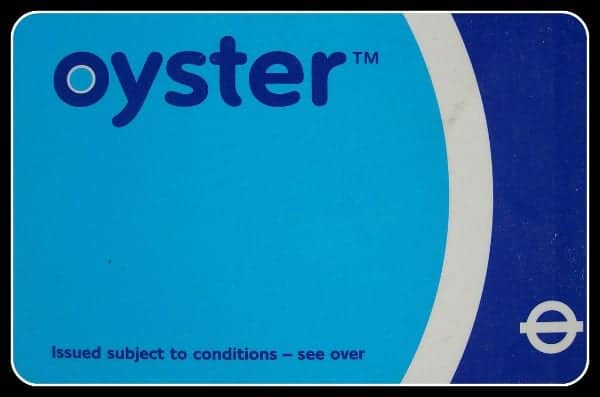
There are 2 different types of Oyster Cards: a Visitor Oyster Card and a Regular or Standard Oyster Card . They function in essentially the same way but with a few key differences.
For example, both cards operate on a pay-as-you-go basis, but only the Regular Oyster Card can also load travelcards, which are 1 day, 7 day or 1 month passes.
We explain more of these differences in the following sections .
NOTE: The T urboPass , one of the tourist discount passes, includes a Visitor Oyster Card for free.
Children under the age of 5 can travel on all London transport networks for free (including the Underground, TfL Rail, and buses), provided they are with an adult who has a valid Oyster Card, Travelcard, or single-ride ticket.
Children aged 5 - 10 can travel for free with the Zip Oyster Photocard .
Children from 11 - 15 qualify for a ZipCard (free travel) or a Young Visitor Oyster Discount, which is a discount added to a regular Oyster card and is valid for 14 days.
Single fares and daily cap for the underground and buses are 50% cheaper than adults with this discount.
To get it, you must pay a non-refundable £7.00 fee. Or, if you are only in town for one day, you can pay for a 1-Day children's Travelcard.
Only one person can use one card. If you have 2 or more travelers, you will need 2 or more Oyster Cards.
Using Contactless Debit and Credit Cards

Contactless payment cards are now accepted across all London transport networks and ask in the same manner as an Oyster Card. See if yours is valid here .
The majority of Londoners now simply use their contactless debit/credit cards rather than an Oyster card - and you can, too!
(Please make yourself aware of your bank's policies and card issuer policies before you travel. Most contactless cards will work including visa, Mastercard and American Express, but you may be subject to foreign transaction fees.)
This means there is no preparation needed when planning to take the Underground, you simply tap in and out with your payment card.
You also don't need to worry about 'topping up' before you make any journeys.
Contactless cards are also subject to the same price capping as an Oyster Card, so you never pay more than you would have spent had you purchased a daily travel card.
You are also able to take advantage of the 'bus hopper' fare. However, you won't get the same discounts available with the Visitor Oyster Card .
To learn how to use the cards and other tips on using the underground, read our post on navigating the London Underground .

Using Google Pay or Apple Pay
If you have Google Pay or Apple Pay on your smartphone or smartwatch, then you don't need to buy an Oyster card, or a travel card, at all!
These two payment methods will get you the exact same rates, and price capping (listed below) that you would be subject to when using an Oyster Card.
This means there is no need to go through the extra steps of buying one and topping up.
As with contactless credit and debit cards, you are also able to take advantage of the 'bus hopper' fare.
However, you won't get the same discounts available with the Visitor Oyster Card .
Benefits of Using an Oyster Card
Below we list the general benefits of an Oyster Card, whether it's a Visitor or Regular Oyster Card.
But remember, as of 2023, all of these benefits and rates apply to visitors using their contactless cards, Google Pay, and Apple Pay!
Cheaper Than Single Paper Tickets
Actually, they are much cheaper. As you can see below, most visitors traveling in Zones 1 and 2 can save between £2.50 and £3.50 per ride.
Most visitors to London stay within Zones 1-2, central London, though some have hotels or guesthouses outside of the city centre.
If you are flying in and/or out of Heathrow Airport, then your fare would be from Zone 1-6 to wherever your final destination is.
The Elizabeth Line to Heathrow Airport is priced differently - any journey to Heathrow that begins, or passes through Zone 1, is priced at £12.20 - £13:30, depending how Far East you travel.
Children under 11 travel for free and there is a 50% discount on Oyster Card fares for children 11-15 years of age with the Young Visitor Oyster Discount.
To receive this discount, you need to speak to a Tube staff member at any Underground station, including Heathrow, or you can purchase it on the automatic machines in any station.
Daily Limit
In addition to cheaper individual rides, when traveling with an Oyster Card, a 'cap' is automatically applied once you reach a certain amount each day.
For example, the most you will ever spend in one day when traveling within zones 1 & 2 with an Oyster Card is £8.10 . For the Young Visitor Discount (ages 11 - 15), the cap is £4.05 .
There are different caps for each zone as the cost of travel depends on the distance you go and the time of day.
We recommend how much to put on your card per day, but you can see the price and cap table here.
Buses also cap out at £5.25 per day (with each ride costing £1.75).
Contactless debit and credit cards are also subject to price capping!
Hopper Fare on Buses
The London mayor recently introduced the 'hopper' fare.
This means that you will be able to switch between as many buses as you like within 1 hour without being charged more than the initial £1.75 fare.
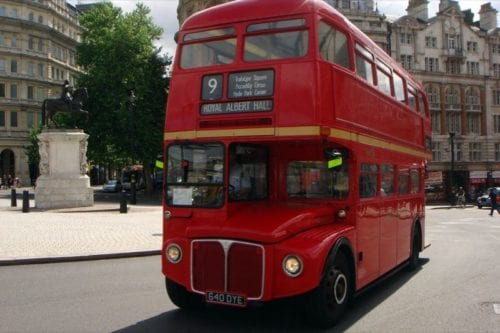
London is huge and many journeys require that you take 2 or more buses to get there.
With the hopper fare, you will only need to pay £1.75 total for all of those rides as long as the total time does not exceed 1 hour. Note that the hopper fare is applicable for all journeys made by bus & tram!
Valid to get to and from Central London Heathrow and Gatwick Airports
Heathrow Airport is at the very end of the Piccadilly Line, and on the new Elizabeth Line , and therefore can be reached via the Underground with an Oyster Card or Travel Card.
Unfortunately, Oyster Cards do not work on the Heathrow Express - yet!
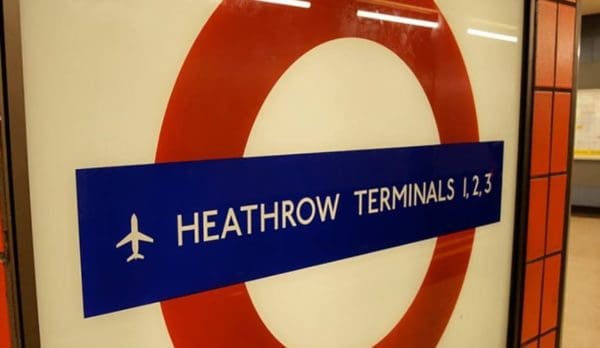
Gatwick Airport, which is not on an Underground Line, can only be reached by bus or train.
Oyster Cards can be used on the Gatwick Express, which is the fastest train from Central London to that airport.
Oyster Cards Never Expire
If you plan to visit London again in the future, then you can simply hold onto the card and it, as well as the money on it, will never expire.
Your £5 purchase will be refunded automatically as pay-as-you-go credit after one year when you make a journey with your card.
You must collect your refund within six months or you won't be eligible to receive it.
NOTE: There is a limit of £10 on refunds.
VISITOR OYSTER CARD
The Visitor Oyster Card can be purchased in advance and mailed to you anywhere in the world.
This is great for those of you who feel stressed out about the idea of buying an Oyster Card while in London, and therefore would prefer to just have it sorted prior to arrival.
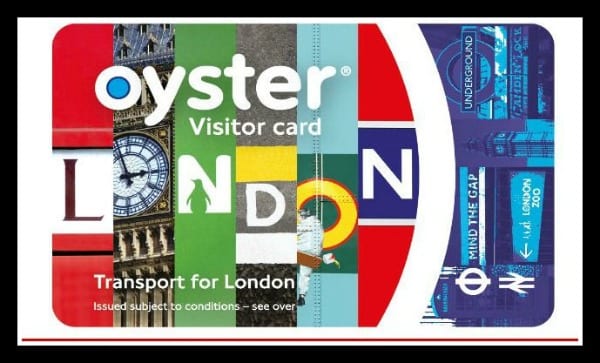
Adding money to your card is easy and we explain this process in the next section .
However, there are a few drawbacks to the Visitor Oyster Card. Firstly, it costs £5 plus postage for the card to be sent, and unlike the Regular Oystercard, you won't get the £5 back.
Secondly, you can't register a Visitor Oyster Card, something you can do with a Regular Oyster Card.
So, if you have a tendency to lose things, then this might be a consideration for you.
The larger drawback is that you can't apply any of the Travelcards (these are explained later) to the Visitor Oyster Card.
So, if you were planning on using those, or put it another way, you plan to be in London for 6 or more days, then maybe don't buy a Visitor Oyster Card.
There are also some discounts that can be applied to certain restaurants and tourist attractions with the Visitor Oyster Card.
None of the deals are that spectacular and you generally get much better discounts with a tourist attraction discount pass but check out their list in case any appeal to you.
Ultimately, if you want to have your card before arriving in the UK, or are not likely to benefit from a travelcard, then buy a Visitor Oyster Card.
Regular Oyster Cards can only be purchased in the UK.
They are very simple to buy and can be purchased all over the city, including the airports, but if you don't want to bother with that, then opt for a Visitor Oyster Card.
REGULAR OYSTER CARD
Just about everybody who lives in London used to have an Oyster Card! These days, however, most of us use our contactless cards instead. You'll also see many a Londoner scanning their phone or watches when going in and out of the tube barriers.
However, if you'd still like to use an Oyster card, keep reading to find out more. Note that Oyster fares are the same fares you will pay using your contactless cards, phones, or watches.

You simply add money onto your card at either a Tube station (all stations have kiosks where you can add money via cash or card), or online.
Or, you could top up at any of the roughly 4000 shops in London where you see an Oyster Card sign. These are called Oyster Ticket Stops.
You can also top up your Oystercard at a Transport for London visitor centre, including Heathrow Airport, Kings Cross St. Pancras International Station, Victoria Station, Piccadilly Circus Station, and Liverpool Street Station.
It is very simple to do and we walk you through this process in the next section.
The other options are to load your Oyster Card with a 1-Day-Travel Card, Monthly Travelcard, or even a Yearly Travelcard.
We explain more about Travelcards and when you should choose them later in this post.
Oyster Cards are reusable so you can load and reload your card as many times as you need to while you’re here.
Visitors can even take their Oyster Cards back home with them and either keep them as souvenirs or hold onto them until their next trip to London!
How to Buy a Regular Oyster Card
To get yourself an Oyster Card you can simply go to the window at any London Underground Station, including Heathrow Airport, and request one, or use some of the many self-service ticket machines at busier Underground Stations.
You will need to pay a £7.00 deposit, which will be refunded automatically as pay-as-you-go credit after one year when you make a journey with your card.
In addition to collecting your deposit at, you can also retrieve any extra money you put onto the card that you have not yet spent, up to a £10 limit.
However, the money you have loaded onto your Oyster Card does not expire, which means if you don’t spend it all before you leave, it will remain on your card until your next visit.
So if you plan to come back, simply hold onto your card.
For those who like to plan in advance, and don’t mind a non-refundable deposit of £5.00, it is possible to order a pre-loaded Visitor Oyster Card to be sent to you before you even leave the house!
How to 'Top Up' an Oyster Card
When using your contactless cards, or Google or Apple Pay, topping up is a step you get to skip.
However, for those of you still wishing to use an Oystercard, topping up is simple!
You simply go to a kiosk inside any Underground station and tap your Oyster Card on the ta card reader.
Select how much money you want to add to the card. Pay that amount either by credit/debit card or cash.
Then tap the yellow card reader again to close the deal. Watch the video below for a visual guide.
Alternatively, as mentioned above, you can also add money to your Oyster Card at any of over 4000 shops that have the blue "Oyster Card" sign in their window.
These are called Oyster Ticket Stops. These are literally EVERYWHERE, so don't worry about not being able to find a place to top up.
The one thing you should be mindful of is that you cannot top up your Oyster Card on a bus or at a bus stop.
If you board the bus and it flashes red for insufficient funds, the driver will tell you to leave.
Luckily, there is usually a business-savvy shop nearby that offers top-ups, but this is something to watch out for if you are planning to travel by bus.
How Much Money Should You Add?
Because of the daily caps, you can have some certainty as to how much you need to add to your card.
Below is an example that assumes that you will be flying into and out of Heathrow Airport (during peak hours), will otherwise travel exclusively in Zones 1-2, and also assumes that you will reach the cap each day.
These prices could be slightly higher or lower, so do check out the fare table to make your calculations.
- 1-Day - £21.50 (see note below)
- 2 Days -£30.40
- 3 Days - £45.60
- 4 Days - £60.80
- 5 Days - £76.00
- 6 Days - £91.20
- 7 Days - £106.40
A 1-Day Travelcard is cheaper than a Visitor Oyster Card if you are only in town for the day as you won't get the £5 fee back.
Though, this does not take into account any discounts that you might use with the Visitor Oyster Card.
You can also use the single fare finder on the Transport for London website to help you budget: www.tfl.gov.uk
TRAVELCARDS
Travelcards are prepaid cards that give you unlimited access to specific zones within London.
You can choose to either order these in advance (in which case you will be given a paper Travelcard) or you can buy them upon arrival (in which case you will be using a plastic Oyster Card with the Travel Card loaded onto it).

They work in the same way and can both be used on the Underground and buses and also give you a 3rd-off discount on Uber Boat Thames Clipper rides.
The only difference is that you must pay shipping and handling fees to receive the paper card, and in our opinion, these are much easier to lose!
As mentioned above, there are 4 different durations of Travelcards, but the most pertinent to visitors are the 1-Day Travelcard or the 7-Day Travelcard. (There's also a 1 Month and 1-year travelcard)
However, there's little reason you would ever need the 1-Day Travelcard as there is already a cap on Oyster Cards that limits the amount you can be charged per day (£8.10).
In fact, you will likely lose money if you choose the 1-Day Travelcard over a standard Oyster Card.
However, the 1-Day Travelcard makes you eligible for the 2-1 ticket program when travelcards are purchased from National Rail stations.
Many of London's top attractions allow you to get 2 tickets for the price of one when you show a valid travelcard.
A 7-Day Travelcard can be worth your while, as a 7-Day Travelcard for Zones 1-2 is £40.70 which works out less per day than the £8.10 daily cap.
It might also be worth considering if you purchase it through the London Public Transport Card , which includes a free private airport transfer.
For children over the age of 5, a one 1-Day Travelcard is £7.60 off-peak or £10.75 any time.
Don't forget that a contactless debit or credit card will 'cap out' at the price of a daily travel card meaning you never have to decide whether or not it's worth the money for your daily journeys.
GROUP DAY TRAVELCARDS
If you are visiting with 10 or more people, then a Group DayTravelcard may be the way to go.
All ticket holders must travel at the same time for the tickets to be valid, so keep that in mind!
Group travel cards are valid Off-Peak only so they are usable from 9:30 on Mondays to Fridays but any time on weekends and holidays.
Group travel cards cover Zones 1 - 6 and cost £10.00 for adults and £5.00 for children aged 5 - 16.
These can be purchased in advance or from ticket machines at Underground stations.
WHICH ONE, IF ANY, SHOULD YOU BUY?
As we said above, if you have Google Pay or Apple Pay on your smartphone or watch, just use that! If you don't, read below to find out the best option for your travel needs.
This depends on what it is you want to do and where you want to go! Note that the London Underground Map is divided into 9 different zones.
Zones 1 and 2 are in the centre, where most of the popular visitor attractions are.
When traveling across London, it’s worth remembering that the further outside of Zones 1 and 2 you need to go, the more expensive your journey can become.
As a general rule of thumb, you can determine which ticket will be best for you depending on the length of time you are in town.
In London for 4 Days or Fewer
Pay-As-You-Go: The best part of Oyster Card (or contactless debit/credit card) Pay-As-You-Go is that you will never be charged more than it would cost to purchase a 1-Day-Travelcard.
Once you have spent the equivalent amount on your Oyster Card, that you would have spent for a 1-Day-Travelcard, your Oyster Card will stop deducting money from your Pay-As-You-Go balance.
Note: Oyster Card Pay-As-You-Go can also be used on KPMG Thames Clipper River services!
In London for 5 Days or Fewer:
If you are not going to be in London for a month, which you can purchase a travel card for, then just using pay-as-you-go is your best option by far.
What are the Ticket Rates for 1-Day-Travelcards?
Rates vary depending on the time you wish to travel and how many zones you want to cover.
Zones: Most London attractions are within Zones 1 – 2 but a Zone 1 – 6 covers absolutely all of them, as well as Heathrow airport!
Time: 1-Day Travelcards and single-fare paper tickets come in two different formats: Peak and Off-Peak.
Peak means that you can use your ticket or 1-Day-Travelcard any time to travel on the Underground.
Off-Peak means your ticket is not valid on weekdays between 6:30 - 9:30 am or from 16:00 - 19:00 (4 pm till 7 pm) Mondays through Fridays.
Peak and Off-Peak do not apply on Single Cash fares or bus journeys.
NOTE: Don’t forget that you can get the 1-Day Travelcard with a London Public Transport Pass , which also provides a private transfer from the airport to the city center.
If you need both services, this could be a good way to lower the overall price you’ll pay for a 1-Day Travelcard.
Anything Else?
We have some more interesting facts on our blog . This guide is only an overview of the most popular, cheapest, and easiest tickets you may need while you are in London.
However, for more information, including tickets for children, travel beyond Zone 6, or bus and tube maps please see the Transport for London Website: www.tfl.gov.uk .
If you found this post helpful, please share this with friends and family. Also, be sure to check out our pay-what-you-like London walking tours .

Choose a Destination... I want them all PLUS general travel tips. Amsterdam Berlin Boston Charleston Chicago Dubai Lisbon London Los Angeles Miami Nashville New York City New Orleans Paris Philadelphia Prague Rome San Francisco Washington DC
About The Author

North America
United kingdom & ireland, middle east & india, asia & oceania.
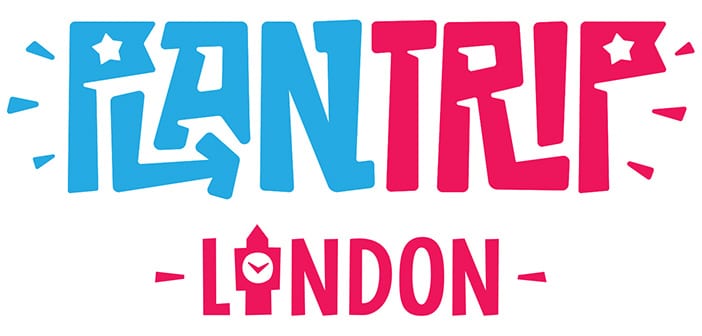
London Oyster card

The Oyster Card is the most recommended option for use to travel on London´s public transport. It is what Londoners tend to use on a daily basis for commuting, and it is normally the cheapest way for tourists to get around London.
In this article we will explain what the Oyster card actually is, how it works and how to decide if it is the right option for you if you are planning a trip to London. Paying for your travel in London with an oyster card is much cheaper than paying for single tickets, but we will tell you how this works in detail in this article.
What is a London Oyster Card?
Visitor oyster card: the london oyster card for tourists.
Visitor Oyster Card Discounts
- Bon Vivant Restaurant in Bloomsbury: Free Prosecco or fizzy drink per person.
- Brasserie Blanc Restaurant: 20% discount.
- Paul: Free croissant when ordering a hot drink before 11 am.
- Skylon: 10% discount on food and drink.
- London Transport Museum: 15% discount on food and drink from the museum cafeteria.
- Kew Gardens: 10% discount in-store and hot drinks in the cafeteria.
- London Bridge Experience: 2-for-1 tickets are available when visitor oyster cards are presented at the ticket office.
- Foyles Bookstores: 15% discount.
- Beatles Store: Free souvenir bag from the Beatles store when you spend over £5.
- M&M’s store: 15% discount on all products in the store.
Some of these offers are subject to change – please check with TFL!
Do I need an Oyster Card if I visit London?
The simple answer to this question is yes, unless you have a debit or credit contactless card that you can use.
The Oyster card guarantees you the absolute minimum fare for each journey, and the daily cap makes it a no-brainer. Even if you are in London just for one day, if you are going to use public transport a few times during the day, it works out cheaper to buy an Oyster Card and use this to get around, rather than paying for single fares every time. What is more, you can’t pay cash on a London bus any more, so if you are planning on using the bus, you will need a valid oyster card, travel card or contactless card.
A few years ago, we used to recommend the oyster card to everyone – or a travel card if you were staying in London for more than five days. We now recommend using contactless payment on London Transport – as the fares applied when using contactless are exactly the same as if using an Oyster Card.
How does the oyster card work?
Using the oyster card on london underground, overground and dlr.
To use the oyster card for travelling on the London Underground, Overground, DLR or trains, you simply have to touch the yellow card reader that is located to your right at the barriers with your oyster card. The barriers will open as soon as you touch the yellow reader if there is enough balance on the oyster card. Once you have completed your journey, you will need to touch the yellow reader again with your oyster card for the barriers to open when you exit the station.
The fare that you pay using an oyster card will be calculated at the time you touch the yellow reader at the exit barriers. The fare will depend on the travel zones that you have travelled to and from and the time of the day that you have travelled, as there are peak and off-peak fares.
This is why one oyster card is needed for each person. If you fail to touch the reader with your oyster card when you enter or exit, you will pay the maximum fare possible as a fine, so if you get to the station and you find that the barriers are open, make sure you use your oyster card to touch the reader anyway to make sure you pay the right fare.
Using the oyster card on the bus
To use the oyster card for getting around London on the bus, you only have to touch the yellow reader with your oyster card when you enter the bus. There is a reader next to the driver and another one by the back door on the new double-decker buses. You don´t need to touch the reader again when you leave the bus.
Where to buy a London Oyster Card or a Visitor Oyster Card
Buying an oyster card at underground stations.
You can buy a London oyster card at any underground, overground, DLR or TFL rail station in London. At these stations you will be able to buy an oyster card at the ticket office or at one of the self-service machines. You can also buy the oyster card at the Heathrow airport underground station and you can also buy a Visitor Oyster Card at Gatwick airport train station.
Buying an Oyster Card at Oyster Ticket Shops
It is also possible to buy the London oyster card in some shops in central London, these shops will have a sticker displayed on their door or window with the words “Oyster Ticket Shop”.
Buying an Oyster Card Online
You can also buy a Visitor Oyster Card online at Visit Britain shop .
How to top up a London oyster card
You will find self-service machines at each underground, overground, TFL rail and DLR stations where you can top up your oyster card. To do so, you just need to tap your oyster card on the yellow card reader and follow the instructions on the screen.
You can top up your oyster card with cash, or you can choose to add a travel card to your oyster card. Travelcards entitle you to unlimited travel for the zones and number of days chosen. Normally, if you are going to be spending more than five days in London, then a 7-day travel card is probably advisable. However, if you are going to be in London for less than five days, then we recommend that you just use your oyster card with pay-as-you-go and top it up when necessary.
You can use a debit/credit card or cash (coins and notes) to top up or add travel cards to your oyster card. Once you have paid for your top-up, you need to confirm the transaction by tapping the yellow reader again with your oyster card. If you don’t do this, your oyster card will not be topped up.
Do not forget that you must tap the yellow reader with your oyster card twice: at the beginning and at the end of the process.
How much does each journey cost when you use an oyster card?
- London Travel Zones: the fare that you pay will depend on the travel zones that you travel to and from. See more about London Travel Zones here: London Travel Zones .
- Time of the day: The fares will depend on the time you travel, as there are peak-time fares and off-peak fares. Peak times are considered 6.30 am – 9.30 am and 4 pm – 7 pm Monday – Friday (excluding bank holidays. If you travel during off-peak times, the journey will normally be a little cheaper.
Oyster card and Visitor Oyster Card Fares from 5th March 2023
Returning your oyster card.
Until now, we could return our oyster card when we no longer needed it and get the deposit back (used to be £5) along with any remaining balance. This is still the case if you bought your oyster card before February 2020, but if you bought your Oyster Card after February 2020, this is no longer the case.
Oyster cards bought before the 23rd of February 2020
If you bought an oyster card before the 23rd of February 2020, you can return it and get your £5 deposit back.
If you already have an oyster card, bought before February 2020, you can use it to travel on London’s public transport as it does not expire. You can also lend it to someone if someone you know is visiting London.
Oyster cards bought before the 23rd of February 2020 can be returned and cancelled, and when you do so, you will be able to claim the deposit back and any remaining balance. If the remaining balance is less than £10, you can use any self-service machine at any underground station. Just touch on the yellow card reader with your oyster card, and choose refund or return oyster card. If the balance on your oyster card is greater than £10 you’ll need to go to the ticket office at the station. They will normally give you cash. You can also register your card on TFL’s website and cancel your card once logged it, and any remaining balance will be transferred to your bank account.
So, for example, if you have an old oyster card with £2.80 balance, you can still claim your £5 deposit plus the £2.80 balance.
Oyster cards bought from 23rd of February 2020 to 3rd of September 2022
If you bought an oyster after the 23rd of February and before the 4th of September 2022, you will get the deposit back automatically as credit on your oyster card a year after you bought it.
This is good news if you bought your oyster card and are going to continue using it, but if you never return to London, you won’t get your deposit back.
If you ever travel to London again, you can use your oyster card again, and the deposit will appear on your oyster card as credit. You can also lend your oyster card to a friend or relative if they are visiting London, as it does not expire.
You can also register your card online and, after a year, cancel it and request the credit be transferred to your bank account through their website.

Oyster cards bought after the 2nd September 2022
If you bought an oyster card after the 4th of September 2022, you will no longer receive the deposit as credit on your oyster card after a year, and you won’t be able to get a refund for the fee paid (£7) if you do cancel your oyster card. You will still be able to get any unused credit back and cancel your oyster card.
More information on using Public Transport in London
Using contactless.
It is possible to use a contactless debit or credit card to pay for public transport in London. To do this, you simply need to touch in and out on the yellow reader when using it for travel on the underground or overground and trains or DLR, or just touching in when you get on a bus. One contactless card is needed for each person.
The rates that apply when using contactless card are exactly the same as when using oyster card, with the same daily capping.
The only drawback is that if you are not a UK citizen your bank may charge you commission, and this could actually make travelling in London much more expensive than using an oyster card.
Travelling in London with kids
Generally, children under the age of 11 travel free when using London’s public transport, but we have written an entire article to explain how and when they can travel free and what transport passes they can get if they are older than 11.
⇒ More information: Travelling in London with kids
London Travel card: The other London transport card
The travel card is the other transport pass available for use to travelling in London. You can buy 1 day, 7 day, monthly or annual travelcards for specific transport zones in London .
Generally speaking, a daily travelcard is more expensive than the daily capping applied to an oyster card, so we don’t normally recommend daily travelcards. The 7 day travelcard is useful if you are going to spend more than 5 days in London, as for anything else I would normally still recommend that you used oyster card pay as you go.
Related Posts
London underground, london travel zones, contactless payment on london transport, 14 comments.
Hi I visit London about two or three times a year as a rail photographer (hobby not professional) I always use a Travel Card but I’m thinking towards an Oyster Card
I could, lets say travel from Waterloo to Clapham Junction & spend a couple of hours there before moving on. If I were to get an Oyster card how would this work for me if I dont leave the station immediately?
It depends on how long you spend at the station without touching with the Oyster Card to get out. The important part would be to at least go outside at an Station before you go back to the first station where you started your journey. If you don’t get out anywhere and then you simply change platforms and go back to the first station, you will be charged the maximum daily amount.
Hope it helps!
what time does the shop open for me to buy the card at heathrow as I arrive at 5.30am on a sunday morning?
Hi, You should be able to buy an oyster card from the self-service ticket machine at Heathrow underground station. Hope that helps!
Does the oyster card have an expiry date- I bought one some years ago and have not used it since or asked for a refund
Hi David, sorry about the delayed response. We were off yesterday.
In theory the credit you have on your Oyster card never expires. If the card stops working for any reason, just go to one of the stations and talk to one of the assistants there, they should be able to give you a refund.
This is what TFL says on their website: “The pay-as-you-go credit on your Visitor Oyster card never expires, so you can keep your card until your next visit or lend it to family and friends.”
I hope that helps!
Have a nice day.
Hello and GD: My question is as follows? I am planning to visit your nation in the coming month’s. How do I know if my financial institution will charge a commission or not ? I will be coming from the state’s. I am thinking of getting an oyster cd.
Hi William, it might be a good idea to ask your bank what commission rates they apply when using your card abroad. One option is to get a card that you can use abroad without paying commissions or extra fees when used abroad, these are made specifically for travelling and can work out much cheaper. We sort of explain it briefly in this article: https://plantriplondon.com/contactless-payment-london-transport/ Hope that helps!
To tell the truth, it is so wonderful that you enlightened people about the London Oyster card because this card can provide you with a wide range of opportunities and can be a truly necessary attribute in your travelling. I can say that this card has a great deal of advantages and can make your trip more comfortable if you use it in the right way. I really like the fact that it is possible to return the card and get your £5 deposit back because it saves you from many difficulties. I think that such cards are a necessary thing during your journey because it is a really profitable way to travel by public transport and it is a really modern solution.
Thank you for your comment Marina!
how far out of London does an oyster card work? i live in Kent, at what point on a journey from London Victoria does an oyster cease to be valid?
Hi Glen, On this TFL´s map you will see oyster´s pay as you go area which is basically London Fare Zones 1 – 9: https://content.tfl.gov.uk/london-rail-and-tube-services-map.pdf You will also find a bit more info here: https://tfl.gov.uk/fares/find-fares/national-rail-fares-beyond-zone-9 But if you let me know what station you´ll be travelling to London to and from I can look into it a bit more for you. =)
Question If you get on a bus , use your card and get charged 1. 50. , only go 2 stops to change to another bus , when you get in the next bus , are you charged another 1.50 ??
Hi Mike, No, you would only pay £1.50 for both journeys, as long as you touch in on both buses with the same oyster card within one hour. This is called the “Hopper fare” – you get unlimited journeys on London buses for £1.50, for one hour. Hope that helps!
Save my name, email, and website in this browser for the next time I comment.
Notify me via e-mail if anyone answers my comment.
Type above and press Enter to search. Press Esc to cancel.

- Places to Visit
- Sightseeing
- Practical Tips
- Where to Stay
London Underground Tickets & Travelcards
The Travelcard is a transport pass for London that gives you unlimited travel in London within certain zones . The prices vary according to the number of zones you need to travel through. Central London is in zone 1.
Travelcards are valid for 1 day, 7 days, 1 month or 1 year.
The passes are valid for travel on all types of transport in London including:
- the Underground (the tube)
- the local suburban trains within London
- the Elizabeth Line (not west of West Drayton)
- the Docklands Light Railway (DLR)
- the London Overground
- the buses all over London. A Travelcard for any zone allows you to use the buses in all zones (zones 1-6)
The 3 Day Travelcard, weekend Travelcard, Zone 1-2 & 2-6 One Day Travelcards are no longer available.
Visiting London for 1-7 days? See our guide to London’s transport tickets & passes . The Travelcard may not be the best ticket for your stay.
Single Underground Tickets
Single paper tickets on the London underground are expensive if you buy them from a tube station ticket machine:
- £6.70 for one journey in zone 1 (central London) and between zone 1 and zones 2 to 6
- See single ticket prices for all zones .
One Day Travelcards: 2024 prices
Using a Pay as you go Oyster card or a contactless card are the cheapest ways to pay for travel if you’re in London for 1-5 days. The daily cap is £8.50 per day for zones 1-2
If you really don’t want to use an Oyster card or don’t have a contactless card, the One Day Travelcard is the next best money-saving pass.
The paper Off peak One Day Travelcard for zone 1-6 is £15.90. This is expensive, but still cheaper than paying the full cash fare for 3 underground trips in central London (3 x £6.70 = £20.10 ).
One Day Travelcard fares from 3 March 2024
Peak v anytime travelcards.
One Day Travelcard prices are different if you travel during peak or off-peak times:
Anytime Travelcard Valid for travel at anytime. Off-Peak Travelcard For travel after 9.30am Monday–Friday and all day Saturday, Sunday and public holidays.
Top Tip: An Off-Peak One Day Travelcard for zones 1–6 costs £10.40 with a Railcard .
Weekly Travelcards: 2024 prices
If you stay in London for 6–7 days and use the underground, trains, and buses every day, the weekly Travelcard is the most cost-effective travel pass.
The one-week pass including central London (zones 1-2) is £42.70.
- It can start on any day of the week
- It’s valid for travel at anytime; there is no peak or off-peak rate.
Most places sell weekly Travelcards loaded onto a plastic Oyster card. There’s a £7 fee for the Oyster card.
Your fare on an Oyster card will automatically cap at the weekly Travelcard fare (this is already available on contactless cards). The cap starts on Monday and ends Sunday, so it mainly benefits Londoners or those working in London.
Weekly Travelcard fares from 3 March 2024
- See weekly Travelcards prices for all other zones (2, 3, 4, 5 and 6)
Monthly Travelcards: 2024 prices
For longer stays in London, monthly Travelcards are available. You won’t save much compared to buying 4 x weekly Travelcards – but you’ll save time renewing it. Like the weekly Travelcard, it can start on any day of the week and is valid for travel at any time. See monthly Travelcard prices for all other zones (2, 3, 4, 5 and 6)
Monthly Travelcards from 3 March 2024
Where to buy travelcards.
One day, weekly and monthly Travelcards are available from:
Underground stations
Travelcards are available from all underground station ticket machines (there are no longer any underground tickets offices). The busier stations in central London have staff to help you use the machines.
Local shops and newsagents
Travelcards are also available from Oyster ticket stops . These are newsagents and local shops licensed to sell London transport tickets and Oyster cards. One Day Travelcards are not available from Oyster ticket stops.
London train stations
One Day Travelcards are available from all London train station ticket offices and ticket macines. Paper weekly and monthly Travelcards are no longer available from train stations . They are available to buy, but they are loaded onto an Oyster card and may only be available from ticket machines, not ticket offices.
London Transport Visitor Centres
TfL Visitor Centres at Victoria train station, Kings Cross/St Pancras International station, Heathrow Terminal 2 & 3 tube staion, Liverpool St station & Piccadilly Circus tube station.
How to use a Travelcard
On the underground.
If you have a paper One Day Travelcard or single ticket from a ticket machine, insert the card into the slot on the front of the ticket barrier. The barrier opens when you take the ticket from behind the yellow reader, on the top.
If you have a paper One Day Travelcard, just show it to the driver when boarding the bus.
See How to use an Oyster card if you have a weekly Travelcard on an Oyster card.
Top Tip: Do you want a cheaper way to travel around central London? If you only travel by bus , it costs £5.25 per day or £24.70 per week.
Related pages
- Guide to London’s transport tickets
- Weekly and monthly Travelcards for zones 2, 3, 4, 5 & 6
- Oyster card
- How to use a contactless card to pay for transport
- Bus tickets & passes
- London Transport zones
Last updated: 22 February 2024
Transport tickets & passes
- Guide to London's transport tickets
- One day & weekly Travelcards
- Zone 2–6 weekly Travelcards
- Bus tickets & passes
- Oyster single tickets
- Oyster card refunds
- Contactless cards
- Child tickets & passes
- Local train tickets
Useful information
- Plan your journey
- London transport zones
Popular pages
- Left luggage offices
- Congestion Charge
- 2 for 1 discounts at London attractions
- Oyster cards
- Top free museums & galleries
- Cheap eating tips
- Heathrow to London by underground
Copyright 2010-2024 toptiplondon.com. All rights reserved. Contact us | Disclaimer | Privacy
London Travel: Which Oyster Card is Best for Visitors?
:max_bytes(150000):strip_icc():format(webp)/DSC00412-5b73daf7c9e77c0057ca2198.jpg)
With so much to see and do in every corner of the city, transportation is an essential part of your London adventure. One of the easiest and cheapest ways to travel is with an Oyster card, which can be used on the capital's buses, trams, and metro. Oyster cards can also be used to pay for journeys on the DLR, London Overground, Transport for London (TfL) Rail, Emirates Air Line, the River Bus and most National Rail services within the city. In short, an Oyster card gives you full access to all of London's diverse public transport options .
What is an Oyster Card?
An Oyster card is an electronic plastic smartcard that can be loaded with pay-as-you-go transport credit. There are two options available to tourists: the regular Oyster card used by London natives, and the Visitor Oyster card, which is specially designed for use on one-off trips. Both cards work in conjunction with the yellow card readers installed at all transport stations, calculate the cheapest possible fare for each journey, and offer a daily capped rate that makes unlimited travel affordable.
Both versions of the Oyster card are significantly cheaper than traditional paper Travelcards. For example, travel within transport Zones 1 and 2 is capped at a daily maximum of £6.60 with an Oyster card, while a Day Travelcard for the same zones costs £12.30. At the end of your trip, you can request a refund of any unused credit, or give your Oyster card to a friend or family member. Pay-as-you-go credit on both cards is fully transferable and never expires.
Visitor Oyster Cards
If you're traveling to London for a short visit, a Visitor Oyster card is probably the most convenient choice. You can order one online ahead of your trip, and have it delivered to your home so that when you arrive in London, you don't have to waste time queuing to purchase a regular Oyster card. This is especially helpful if your flight arrives at Gatwick Airport, as all Oyster cards can be used on the trains from the airport to central London. Visitor Oyster cards cost £5 (plus postage), and can be pre-loaded with credit options ranging from £10-50.
If you run out of credit during your visit, you can load more money onto your Oyster at any Oyster Ticket Shop (of which there are more than 4,000 across London) or TfL Visitor Centre. It's also possible to load credit at any Tube, London Overground or TfL Rail station, and at several National Rail stations. Visitor Oyster cards are only compatible with pay-as-you-go credit and cannot be loaded with multi-day travelcards or passes in the way that regular Oyster cards can. However, a major advantage of this card is the special offers and discounts it offers at selected restaurants, shops, galleries, and entertainment venues.
Regular Oyster Cards
For long-term visitors, a regular Oyster card could be the more cost-effective option. These cards can only be purchased upon arrival, from Oyster Ticket Shops, Visitor Centers and most London Tube and rail stations. They cost £5 ( refundable at the end of your trip ) and can be loaded with any amount of pay-as-you-go credit. Unlike Visitor Oyster cards, this option can also be loaded with multi-day travel cards that give even cheaper fares for longer stays; or with discount cards including Bus & Tram Passes and National Railcards. Remember that only pay-as-you-go credit can be used by someone else after you leave.
Regular Oyster cards are compatible with the TFL Oyster App, and can be registered with a contactless and Oyster account . The latter allows you to easily see how much credit you have left, to view your journey history and to apply for refunds online.
Alternative Options
If neither Oyster card option sounds like a good fit for you, there are alternative ways to pay for transport in London. Although they don't offer the same discounts, paper Day Travelcards may appeal to those that prefer to keep things traditional. This ticket allows for unlimited travel within a 24-hour period on the bus, Tube, DLR, tram, London Overground, and most National Rail services within London. Discounts are also available to Day Travelcard holders wishing to make use of the Thames Clippers River Bus and the Emirates Air Line cable car.
For the more tech-savvy, contactless cards allow you to pay for journeys of £30 or less by touching the card to the same yellow card readers used for Oyster payments. The benefits of contactless payments over Oyster cards include not having to worry about running out of credit or queuing to top up your Oyster when your credit is running low. Contactless payments on the same card are automatically capped on a daily and weekly basis, so you'll still benefit from reduced fares.
However, if your card is issued outside the UK, you may have to pay overseas bank charges . Similarly, while American Express contactless cards and nearly all Mastercard or Maestro cards are accepted, some other foreign cards may not work on the London transit system. The same issues apply to those intending on using Apple Pay . Check with your card issuer in advance to find out whether your card is compatible, and what charges you may incur by using your card overseas.
London's Best Bus Routes for Sightseeing
A Guide to Free Transport in London for Children
Getting Around London: Guide to Public Transportation
How Do I Get From Gatwick Airport to London?
Stay Cheaper By Staying Close to - Not in - London
What's the Best Way to Bring Spending Money to the UK?
Avoiding Peak Times on the Tube in London
How to Travel from London to London City Airport by Underground and Taxi
Heathrow Airport Guide
Getting Around Sydney: Guide to Public Transportation
Monopoly Board Locations by London Bus
Sightseeing on the Number 11 London Bus
Getting Around Amsterdam: Guide to Public Transportation
Getting Around Frankfurt: Guide to Public Transportation
Getting Around Britain - A Guide to Transportation Options
How to Enjoy a Quick Layover in London on a Budget
Which is better: Oyster, contactless or travelcard?
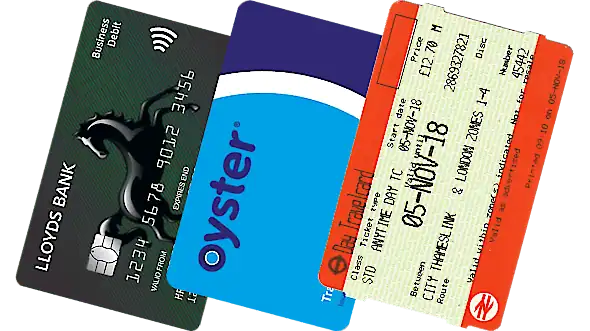
Which card should you choose?
One of the first decisions that a tourist has to make when travelling around London is whether to use an Oyster card , contactless card or travelcard .
The first thing to be aware of is that using cash to buy individual tickets is definitely the worst idea, as single tickets on the train are more than double the cost of Oyster and contactless, and you can’t even buy single tickets on the bus anyway. So which of the three cards do we recommend?
Oyster cards

An Oyster card is a credit card-sized piece of plastic. You load it up with money before you travel and then tap it down on the Oyster card readers on the buses and trains. The computer will then automatically deduct the correct fare from your credit. When you start running low on credit you can just top it up again at a ticket machine.
They come in two different types: normal blue Oyster cards are aimed primarily at the locals, whereas Visitor Oyster cards are aimed primarily at the tourists (although they are basically both the same, so it doesn’t really matter which one you get).
What are the benefits of using an Oyster card?
- The biggest benefit of using an Oyster card is its joint cheapest fares for single journeys (along with contactless)
- The Oyster daily cap is always cheaper than buying a 1-day travelcard
- Oyster pay-as-you-go credit can be used in zones 1-9, whereas travelcards are only valid in the zones you buy them for
- If you register your card online then you can turn on the ‘auto top-up’ feature which takes money out of your bank account whenever your credit gets low, so you don’t have to worry about running out
- Pay-as-you-go credit never expires, so you can carry on using any leftover credit on your next visit
- Visitor Oyster cards also come bundled with a book of discounts vouchers which can save you money at shops, restaurants and entertainment venues. These discounts are constantly changing all the time, but in the past they’ve included things like 10% off a boat ride, 10% off souvenirs in a particular gift shop, or 20% off a meal in a particular restaurant. The instructions for each venue will come with the vouchers, but most of the time all you have to do is show your Visitor Oyster card when you pay the bill, and the staff will apply the discount
What are the downsides of using an Oyster card?
- One of the downsides of using an Oyster card is that you can’t pay two fares with one card, so each traveller in your group will need their own
- The weekly cap only works from Monday to Sunday, whereas weekly travelcards can start on any day of the week you like
- You have to pay a £7 deposit whenever you buy a new Oyster card, or a £5 activation fee when you buy a Visitor Oyster card, which can’t be put towards fares
- You can’t buy a Visitor Oyster card in central London, only the normal blue Oyster cards. If you want a Visitor Oyster card then you have to buy it online in advance and have it posted to you
Contactless cards
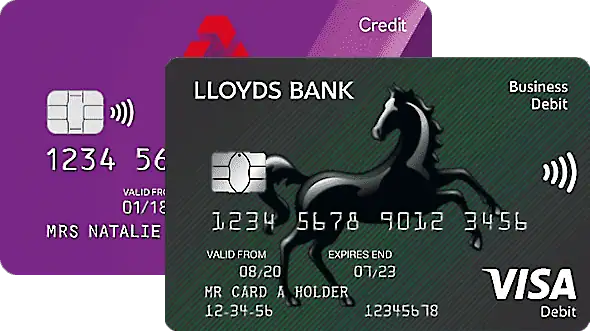
A contactless payment card is just your normal everyday debit or credit card. It works in exactly the same way as a London Oyster card . You just tap it down on the Oyster card readers on the buses and trains and the computer will automatically deduct the correct fare from your bank account.
What are the benefits of using a contactless card?
- One of the main benefits of using a contactless card is that it’s just your normal everyday bank card or credit card, so you probably already have one
- Contactless also has the joint cheapest fares for single journeys (along with Oyster)
- The contactless daily cap is always cheaper than buying a 1-day travelcard
- Contactless can be used in zones 1-9, whereas travelcards are only valid in the zones you buy them for
- Unlike Oyster cards, you don’t have to pay a £7 deposit to set it up
- Unlike Oyster cards, there’s no need to keep topping it up with credit because the money comes straight from your bank account
- Contactless cards can be used in conjunction with Mobile Pay on your phone
What are the downsides of using a contactless card?
- One of the downsides of using a contactless card is that you can’t pay two fares with just one card, so each traveller in your group will need their own
- Unlike with Oyster, you can’t load a travelcard onto a contactless card
- Not all foreign-issued cards are accepted, and foreign cards might have a transaction fee added on by your bank every time you buy a ticket, bumping up the price of your journey
Travelcards
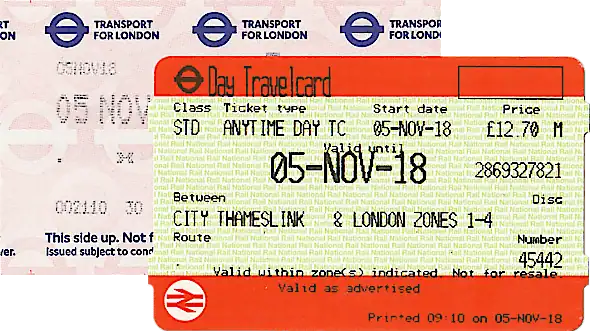
Travelcards are credit card-sized pieces of paper. They can also be loaded onto an Oyster card . You choose the duration you want it to cover (either 1-day, one week, one month or one year), whether you want it to cover just the bus/tram, or the train/bus/tram together, plus the zones you want to travel through, and then you’ll be entitled to unlimited travel in those zones until it expires.
What are the benefits of using a travelcard?
- The biggest benefit of using a travelcard is that you can make an unlimited number of journeys over one day, one week, one month or one year
- Depending on how many journeys you make in total, a weekly travelcard might work out cheaper than the Oyster and contactless weekly cap
- Unlike Oyster cards, you don’t have to pay a £7 deposit the first time you buy it
- You can take advantage of National Rail’s 2-for-1 offer to get cheap entry into 150+ tourist attractions. All you have to do is print out the relevant voucher from daysoutguide.co.uk/2for1-london and then hand it over at the attraction, alongside a valid National Rail travelcard for the same day of travel. But here’s the catch: the travelcard has to be printed on orange paper. That means that you have to buy it from a National Rail station (the big overground hubs like Euston , King’s Cross , Liverpool Street , Paddington , Victoria and Waterloo ). Travelcards bought at London Underground stations are no good, because they will be printed on TFL’s pink paper. And travelcards loaded onto an Oyster card are no good either
What are the downsides of using a travelcard?
- One of the downsides of using a travelcard is that you can’t share one between two people, so each person in your group will need their own
- One day travelcards are always more expensive than the daily cap on Oyster and contactless
- Unlike the pay-as-you-go-credit on Oyster and contactless cards, travelcards can only be used in the zones you bought it for. If you later decide that you want to travel outside of those zones then you’ll have to buy a completely separate ticket
- Travelcards are only valid for 1-day, one week, one month or one year – you can’t buy a travelcard that covers any other stretch of days
How do Oyster, contactless and travelcard fares compare?
Bear in mind that travelcards only allow you to travel between a set period (either one day, one week, one month or one year), whereas the Oyster daily cap and contactless daily cap apply all the time.
You can think of the daily cap as a price ceiling – it doesn’t matter how many buses or trains you ride each day, the maximum amount that the computer will take from your Oyster or contactless card will never rise above the cap.
Peak and off-peak fares – For Oyster and contactless peak fares apply to all journeys that start between 6:30 AM and 9.30 AM (Monday to Friday), or 4.30 PM and 7 PM (Monday to Friday). It doesn’t matter what time the journeys finish. Any other journey is classed as off-peak. Note: Between the 8th March and 31st May 2024 TFL are running a trial called ‘Off-Peak Friday Fares’, where Fridays will be classed as off-peak all day.
For travelcards, off-peak applies to any journey that starts after 9.30 AM (Monday to Friday).
Which is the cheapest: Oyster, contactless or travelcard?
The Oyster and contactless cap is always cheaper than buying a one day travelcard … but bear in mind that you also have to pay an £7 deposit on top the first time you buy an Oyster card , so a 1-day travelcard can still work out as better value.
The Oyster and contactless weekly cap is identical to buying a weekly travelcard, but you need to make enough journeys to make a weekly travelcard worthwhile. If you make at least three or more journeys on six days, or two or more journeys on seven days, then a 7 day travelcard will be worth it, otherwise you should go for an Oyster card or contactless instead.
Where can you use Oyster, contactless and travelcards?
Buses – Oyster cards, contactless cards and travelcards can be used on TFL buses all over London. And because buses don’t have zones you can use a train/bus/tram travelcard in whichever zone you like, regardless of which zones you actually bought it for.
London Underground, London Overground, DLR, TFL Rail, National Rail – The pay-as-you-go credit on Oyster cards and contactless can be used in all of the Oyster zones (1-9), but travelcards can only be used in the zones you bought it for.
You can also use Oyster and contactless on the Heathrow and Gatwick Express, but bear in mind that it won’t count towards the daily cap – it will just be deducted from your credit.
Taxis – Contactless cards can also be used to pay for black cabs (assuming that the fare is less than the current limit of £100). But Oyster cards and travelcards cannot.
IFS Cloud Cable Car & Thames Clipper – You can use Oyster cards and contactless to pay for a ticket on the cable car and Uber’s Thames Clipper service, but bear in mind that the cost will not count towards the daily cap – it will just deduct the relevant fare from your credit. Travelcards cannot be used to pay the fare.
How long do Oyster, contactless and travelcards last?
The pay-as-you-go credit on an Oyster card lasts forever. If you don’t use all the money up during your first holiday then you can simply carry on using it during your next visit.
Contactless cards don’t expire either, because they take the money straight out of your bank account.
A travelcard is the only one with an actual expiry date, because you have to choose a start date and duration when you buy it – either one day, one week, one month or one year. Once the duration has passed then the travelcard will stop working.
Which is best: Oyster, contactless or travelcard?
So which is better? If you’re a foreign visitor coming to London for just one day then we recommend choosing a one day travelcard . The Oyster and contactless daily cap might seem cheaper, but when you factor in the Oyster card’s £7 deposit, and the fact that your bank might add on a transaction fee every time you use a foreign bank card overseas, then a travelcard will likely work out cheaper.
If you’re a foreign visitor coming to London for more than one day then we recommend buying an Oyster card or Visitor Oyster card instead… unless you’re planning on making two or more journeys on seven consecutive days, or three or more journeys on six of those days, in which case a weekly travelcard will work out cheaper.
If you’re a UK visitor then we always recommend using your contactless card , regardless of how many days you’re staying, because the fares are the same as Oyster and you don’t have to pay a deposit to get one.
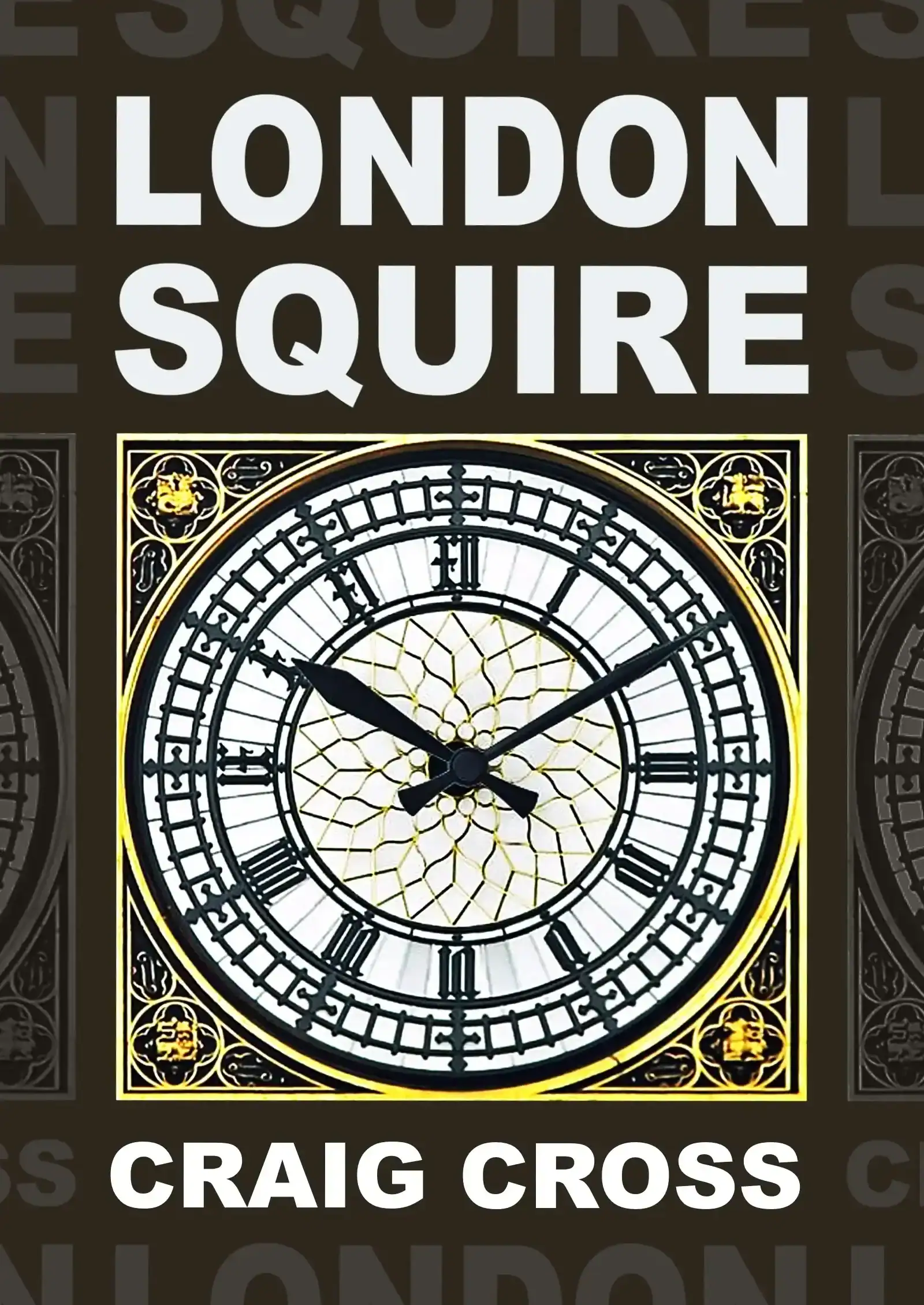
Your comments and questions
Jane Is a two traveling together card, work out cheaper than a pay as go Oyster card
Staff Hi Jane. No, if you're talking about the railcard then it doesn't apply to Oyster pay-as-you-go fares. It's only really any good if you're travelling on trains outside of London - twotogether-railcard.co.uk/using-your-railcard/travel-times-tickets/
JohnP My sister and I are coming to London for a week of museums and galleries. We've been there three times before, but each time I get confused between travelcards, Oyster cards, etc. We arrive and depart through Heathrow, and we're staying near Holland Park/Kensington, so I THINK the 7 Day travelcard is what we should use, but I'm not sure. Any suggestions or help in explaining it more clearly would be greatly appreciated
Staff Hi JohnP. Weekly travelcards always have a start date on them (which you choose when you buy it) and they're valid for for seven consecutive days. You also have to choose which zones you want it to cover. You'll probably want zones 1-2, but it depends where you're going. Oyster cards 'might' be better because they don't have a date on them, they can be used in all the zones, and they cap the maximum price you can spend each day (regardless of how many journeys you take). You can look up the daily caps on our Oyster card page - city-guide.london/transport/oyster-cards.php . This might work out cheaper, but if you're making at least three or more journeys on six days, or two or more journeys on seven days, then a weekly travelcard will be better
Tony Hi. I'm London travelling across zone 1 and 2 for 3 days. Is it right that if I use a contactless card the cap will allow me to travel off-peak for less than a one day travelcard
Staff Hi Tony, that's right. The daily cap for zones 1-2 is only about half the cost of a 1-day travelcard
Bobbie I'll be in England for a month with several train trips. I just purchased a Senior Railcard. Can I get discounted fares on the tube? And how do I use it in conjunction with contactless credit card payment?
Staff Hi Bobbie. Most of the savings come from buying National Rail tickets, The only discounts you get on the tube are 33% off the daily cap for Oyster fares (off-peak only), 33% off single Oyster fares (off-peak only), and 33% off a zone 1-9 one day travelcard (when bought as part of a journey to London from outside London). You have to buy an Oyster card and get the Senior railcard loaded on to it. It doesnt work with contactless because its not possible to load the railcard onto your bank card - senior-railcard.co.uk/using-your-railcard/travel-times-tickets/
Susan Tchudi We're coming to London for ten days. We're staying in Kensington. We've always used travelcards in the past, but we'll probably want to go beyond zones 1 and 2, for example to Kew Gardens. So would it be better to get the Oyster card?
Staff Hi Susan. If youre staying for ten days then it will be cheaper with an oyster card, because you can only buy 1-day and 7-day travelcards. the maximum you'll pay with Oyster is the weekly cap x 1 (which is the same price as a weekly travelcard) plus a daily cap x 3 (which are cheaper than a 1-day travelcard) for whichever zones you travel through. all the caps are here: city-guide.london/transport/oyster-cards.php
JennyJ Hi, I am JennyJ. I go betwenn zone 1&3, there and back 3 times a week and also twice a week to zone 5 (hayes& harlington). I use an Oyster card and top up 20.00 as and when its low. What is the cap for this journey each weekplease. Is it £9 or £11 or neither. I dont know how to work out but dont think I am better off buying a card to cover zones 1-5 as only go max twice a week.
Staff Hi Jenny. The daily cap for the days when you're doing zones 1-3 is £9, and when you're doing zones 1-5 it’s £13,10. a weekly travelcard for zones 1-5 is currently £65,70, so its not worth it - city-guide.london/transport/adult-train-fares.php
Wangui Going through this information has been super helpful, thanks so much! My family of 4 foreigners are coming to London for 11 days from Heathrow Airport and staying at a location in Zone 6, are likely to be visiting attractions in Zone 1 everyday but also traveling to Surrey on 2 days. What is the cheapest means of travel payment to use? -VOC or travel card considering the £7 deposit and postage fee to a UK address for VOC? -If VOC then how much credit should be loaded on the cards? -Also is the weekly/daily cap applied to VOC automatic or how does it work; do the particular days eg Monday, Tuesday, Wednesday need to be specified?
Staff Hi Wangui. If it was me I would probably just keep it simple and get Visitor Oyster cards for everyone, and forget about the travelcards. Visitor Oyster cards have a weekly cap which is the same cost as a weekly travelcard anyway, so you wont be losing anything (apart from the £7 deposit - which you'd have to pay anyway because you'll need something to cover the other four days). How much credit you need will depend on where you’re going. The maximum amount you will pay each day is the ‘daily cap’ for the zones you travel through. The daily cap for zones 1-6, for example, is currently £14,10 - but maybe you’ll only be making 2 journeys each day, going there and back, so then you’d just pay two single fares instead - 2x£5,50 . If the running total between Mon-Sun reaches the weekly cap then the cost will be capped at that (currently £70,30). The caps all get applied automatically. Its all explained on our Oyster card page - city-guide.london/transport/oyster-cards.php
jan Hi, I am currently travelling to work from slough to zone 3, (i would also sometimes go to the other zones (1-6) - by bus/underground after work. I am using the contactless method. The job is Monday to Friday, I wanted to know if buying a weekly/ monthly travelcard would work out cheaper as I also have a 16-25 railcard. Also how does the weekly cap work? does it add your daily charges and refund you if you go over the cap?
Staff Hi Jan. Travelcards usually work out cheaper if you’re making two or more journeys on seven days a week, or three or more journeys on six days a week. You wont get it cheaper with for your railcard either, because it only gives a discount on 1-day travelcards for zones 1-9. I would recommend getting an oyster card instead because the fares and weekly cap are identical to contactless, but you can have your railcard added to it. You can’t do that with contactless. But check the travel times apply to you first, because they might not - 16-25railcard.co.uk/using-your-railcard/travel-times-tickets/ . The weekly cap will kick in when the sum total of all your journeys that week reaches the relevant amount (its the same price as a weekly travelcard). The computer will then automatically stop charging you. Bear in mind that it only counts up the fares between Mon and Sun, and not any other combination of days, like Tue to Mon
frankie Hi, I would like to ask, if you use the same contactless card but one day you use it as the actual physical card and then the next day you use your mobile phone to pay (but with the same debit card) would it count towards the weekly cap?
Staff Hi Frankie. Unfortunately not, no. The computer wouldn't recognise it as the same card because things like Apple Pay don't pass over your card number (it passes over a unique number based on your bank card and device instead). TFL says “Always use the same device or contactless card to touch in and out… For example, don't touch in with an iPhone and touch out with an Apple Watch or contactless card” - tfl.gov.uk/fares/how-to-pay-and-where-to-buy-tickets-and-oyster/pay-as-you-go/contactless-and-mobile-pay-as-you-go
Betty Hi I will be in London for a week. I will be staying at a hotel at the Heathrow airport and going back and forth between there and the actual city of London. Is the Travel card best and what zones would I pick? Thank you
Staff Hi Betty. it depends how many journeys you're going to be making. If you make two or more journeys on seven days, or three or more on six days, then a weekly travelcard will probably be cheaper. We’d normally recommend getting an oyster card. All the pros and cons are described above. Heathrow to central London is zones 1-6.
Canan Hi, I'll be visiting London this summer. My daughter is 10 years old (born in 2013). Is she going to be free of charge or discounted?
Staff Hi Canan. Under 11s are free on the buses and tube (as long as she’s accompanied by an adult on the tube) - city-guide.london/transport/child-train-fares.php
Cristina Grilo Amaral Hi, we are a family of 4 and will be in London for 6 days. We will be riding transport a lot on those days, in zones 1- 2; meaning we should make about 6 tube trips a day. We will arrive and depart via Heathrow so we have 2 journeys (1 outbound, 1 return). Can you please indicate which card you recommend? Thank you so much.
Staff Hi cristina. Price-wise, the best would be a zone 1-2 weekly travelcard put onto an oyster card, and then adding some pay-as-you-go credit onto the same oyster card to cover the two journeys out to heathrow zone 6. But if you want to keep it easy and dont mind paying a bit more, then just get zone 1-6 weekly travelcards instead
Elaine I am travelling with a 14 year old and I would use contactless for myself but what would be the best option for my 14 year old.
Staff Hi elaine. It depends on how many journeys you're making. If you're just talking about one day, there and back, then i would buy her single tickets at the self-service machine (using your card), and then use your card on the gate for yourself. So she will end up paying the adult cash fare, and you’ll get the adult contactless fare.
Mike M We are arriving in London in late May for 3 days and another 4 days in early June after travelling around UK on Britrail Pass. While in London what would be the best card to use on Underground and 1 day to Watford
Staff Hi Mike. I would get an oyster card. there are no dates on those, so you can carry on using your credit when you return in june. You can also use them out to Watford (assuming you’re going to see the Harry Potter studios)
Ali Hi, we are a family of 4 travelling to London over Easter from the UK. We have a friends and family railcard, and I'm just wondering what is the best way for us to travel around, given we will be sightseeing in London for a few days, and also travelling to Paris via Eurostar. We also will be visiting London again in the summer for a few days. It is myself, my partner and 2 kids (ages 7 and 14). Am I right in thinking contactless is best for 3 of us (and doesn't my 7 year old travel free?). Or should I sort getting an oyster cards for us instead? Thank you for your advice in advance. Cheers Ali
Staff Hi Ali. Contactless will be the cheapest for the two adults. Your 14-year-old can't use contactless if they don't have their own bank card (the system doesn't allow you to tap your card down twice to pay two fares), so I would get the 14-year-old an Oyster card and then have the 'Young Visitor Discount' applied to it once you arrive in London - more info about that here - city-guide.london/transport/child-train-fares.php . The 7-year-old will travel for free.
Ali Thank you so much for that perfect and swift response. Amazing!
Sue Can we pay contactless for ourselves and our grandchildren?
Staff Hi Sue. No, each person needs their own bank card. The system doesn't allow you to tap down multiple times to pay multiple fares. What you can do is use your card to buy them a paper ticket at the machine (which will be charged as a cash fare) and then tap down on the gate for yourself (for a contactless fare)
Sue We are coming to London for one day with two grandchildren 12 and 25 years old. If we use our debit contact less card for us can the grandchildren use our credit contactless card? Although we know that would be a full fare.
Staff Hi Sue. If you mean you want to use one debit card to pay two contactless fares, and one credit card to pay two contactless fares, then no. The system doesn't let you tap down twice to pay two fares. Each individual needs their own card. But you can use one card to buy more than one paper ticket from the machine. But then you'll be paying the cash fare.
Hiko Hi,I’d like to know about 7day travel card. I’m plannning to go to Birmingham,Brighton,Wembley,and sightseeing inside zone1-2.(My son loves soccer!) My hotel is in zone1.I will stay there about 8days. If I buy 7day travel card with zone1-2,how can I go outside of that zone? Can I ride the national rail with my travel card such far area?? Does the card pay the difference, when I go outside of the zone2,like Wembley zone4?
Staff Hi Hiko. I would buy yourself an Oyster card and have the travelcard loaded on to that (rather than getting a paper travelcard). Then you can load some extra pay-as-you-go credit onto the same Oyster card to cover the extra fares. You can ride National Rail trains with a zone 1-2 travelcard, but only in zones 1-2. If your journey goes further than that then the computer will recognise that the travelcard covers 1-2, and automatically take the extra money from your pay-as-you-go credit. But places like Birmingham and Brighton are too far away for travelcards and Oyster. You will have to buy totally separate tickets for those.
Siegrid I want to go by train from city airport London to St. Pancras and may pay cash. Is there a chance for paying?
Staff Hi Siegrid. Not sure what you mean by ‘chance’, but you can pay cash at some of the self-service machines, Some will accept cards only, and some cards and cash. it will say which at the top
Peter I have a 7 hour layover at Heathrow and wish to go into Covent Garden for the day. Which is the best option for me to travel into London.
Staff Hi Peter. If that's the only place you're going then I would just buy a single ticket at the machine (zone 1-6). You can choose a return journey and it will give you two single tickets. It's not worth getting an Oyster card or travelcard just for there and back.
Julia Dear all, we a family of two adults and one 12 year old want to spent Saturday and Sunday in London. We would only need zone 1 tickets. We arrive at Gatwick and already organized this transfer by bus because of the train stikes this weeekend. Would You recommend the visitors Oyster or just day travelcards for us?
Staff Hi Julia. If it's just one day then I would probably go for a travelcard, which is easier (they sell cheaper ones just for the bus, if that's what you're planning on doing). The fares with a Visitor Oyster Card are cheaper, but they make you pay an extra £5 activation fee on top the first time you buy one, which would wipe out any savings. But if you think you'll come back to London another time then it would be worth getting Visitor Oyster cards, because you can carry on using the same ones then.
Mike Is a monthly travel card valid for a calander month or 28 days
Staff Hi Mike. It lasts until the previous date the next month. So if you choose a starting date of 20th February it will end on 19th March. If you choose 10th December it will end on 9th January. So it could be a different number of days.
Marcella Am coming to London for two nights with husband, sister and brother in law who has dementia. Will be making trip from Stansted airport to Deptford and home again via Gatwick and staying mostly around Greenwich area. We can use contactless cards but my brother in law can’t really do any cards himself and we can’t use ours to put him through the barrier? Do we just get him a ticket? Are their staff available to help if need be Thanks
Staff Hi Marcella. Its not possible to pay two fares with one contactless card (it doesnt deduct two fares if you tap it down twice). Maybe the best thing to do is get him an oyster card with some credit on it, but tap it down on the gate yourself and send him through the barrier, then just follow straight behind him after youve tapped your contactless card down. It would only take a few seconds to get you both through. Or you could ask a member of staff to help. You can usually find them standing behind the extra wide barrier they always have for wheelchairs and buggies.
Cheryl Stefanik We live in the state of Washington (zip code 98198). What is the charge/fee to order an Oyster card vs. the charge/fee to get a Visitor's Oyster card? Is the only difference in function that we cannot add money to the Visitor's Oyster card online?
Staff Hi Cheryl. there's no way to order an Oyster card online and have it posted overseas. You can only do that with Visitor Oyster cards. If you want a normal Oyster card you'll have to buy it when you arrive in London. There are a few more minor differences. You can't load travelcards onto visitor oyster cards (but you probably wouldn't want to do that anyway). And visitor oysters come with their credit already added, whereas normal oysters will have it loaded on when you buy it. Visitor oysters also have a non-refundable £5 deposit, whereas normal oysters have a non-refundable deposit of £7. The full list of differences can be found here - city-guide.london/transport/visitor-oyster-cards.php
Gordon Jamieson If your journey requires 2 tubes how does contactless work?
Staff Hi Gordon. You tap down at the start of your journey, and again at the end. You don't have to tap down for the station in the middle because you shouldn't have to pass through any barriers when changing platforms. (If you did happen to pass through a barrier then that would be the end of the journey)
Alex A Family of 5 travelling to London in early October. 2 adults, 2 children between 11-15 years, and 1 child who is 9 yo. Which ticket/card should we opt for as the youngest child travels free (I think) and the other 2 children get discounted fares. Can we arrange for a discounted fare oyster card when we arrive in London or do I need to arrange this from Australia before I leave? Or is there a travel card that can be bought for ‘students’? We will spend most of the time in Zone 1/2 but need to go to Watford for the Harry Potter Studios one day. PS we are arriving in London on the Eurostar as I heard you could buy oyster or visitor oyster cards on the train. Thanks, Alex
Staff Hi Alex. You can get Visitor Oyster cards posted to you overseas, buy them on Eurostar, or buy a normal Oyster card when you arrive in London. i would get either of those for everyone (apart from the 9 year old), and then have the ‘Young Visitor Discount’ applied to the kids cards when you’re in London. Its not possible to do that beforehand. it’s explained on this page - city-guide.london/transport/visitor-oyster-cards.php
Carol Two of us are headed to London for 14 days, most of that staying in Fulham. We are def there to sightsee in all directions. I want the card that's best for use on all forms of transportation including the Thames Clipper. Help!
Staff Hi carol. If you have a UK bank card then I would just use that, and pay contactless fares. Otherwise you should get an Oyster card - city-guide.london/transport/contactless-cards.php
HFPOM Hi, me and my wife are staying for 3 months in London, and we will be going from city center to Stanmore. What would be the best option? Thank you
Staff Hi Hfpom. There are pros and cons to all of them, which we’ve described on this page. But you’ll probably find that you’re better off with an Oyster card. If you have a UK bank card then might want to use contactless instead.
Chris Borland Hi, my and and I are coming to London for a long weekend, (Fri-Mon) what do you recommend we use for getting about seeing the sights?
Staff Hi Chris. It depends whether you're from the UK or abroad. Like we say above, if you have a UK bank card then the cheapest fares are with your contactless card. If you have a foreign bank card then you should go with Oyster in case your bank adds on a transaction fee every time you use it overseas
You must enable javascript to leave a comment
> Forum: London Buses, Taxis & Trains
Which Oyster Card? The Best Oyster Card for Visitors
Which Oyster Card is best for London visitors? There are two types of Oyster Cards that you can get when visiting London, and if you don’t have a contactless debit or credit card to use on public transportation, then you’ll definitely need one of them. Here’s a breakdown of the Visitor Oyster Card vs. Oyster Card.
* This article has an affiliate link. It’s an honest breakdown of both cards, and if you decide with this information to buy a Visitor Oyster Card through one of the links in this article, it will earn a very small commission.
Pin this to your London Pinterest board before you keep reading:
What both Oyster Cards have in common
What they can be used for
Both the Visitor Oyster Card and “regular” Oyster Card can be used to pay for the underground, red double decker TFL buses, overground trains within London, the DLR, trams, the Emirates Air Line cable car, and the Thames Clipper River Bus services. Pretty much, any type of public transportation in London.
They both have a daily cap, depending on how many zones you travel through in a day. For example, if you only travel within zones 1 and 2 on a single day, you won’t pay more than £6.60. This video explains how the zone system works.
Both types of Oyster Cards get charged more for peak travel, so you pay more to travel on the Tube, DLR, London Overground, TfL Rail and National Rail services in London 6:30-9:30 AM and 4 – 7 PM, Monday through Friday. Peak doesn’t apply for bus fares.
Using an Oyster Card to get to the airport
You can use either Oyster card to get to or from Gatwick airport or Heathrow airport, but can only use both for the Gatwick Express, not the Heathrow Express. It also doesn’t work for the Stansted Express, and can’t be used to get to Luton airport from King’s Cross station.
Costs and payment
Both Oyster Cards work in the same way— you have “pay as you go” credit on your card, and as you travel, the credit will be deducted. You’ll need to “top up” your card when it’s low, which you can do at just about all underground and train stations in London, including airports.
Oyster Card Expiration
Both cards and the credit on them never expire, and while only one person can use it at a time, you can lend your card to family and friends for their own visits.
Now, here are the advantages and disadvantages of getting yourself a Visitor Oyster card over a regular Oyster card. It should help you figure out which Oyster Card is best for you.
Pros of the Visitor Oyster Card:
– You can get it sent to you before you arrive to London. If you would feel better having your Oyster Card before you touch down in London so then the Visitor Oyster Card is your only option if you’re outside of the UK.
– You get some discounts and extra perks with the Visitor Oyster Card. Honestly, they aren’t amazing, but some of the notable discounts include 10% off your bill at Skylon, 10% off your bill at Where the Pancakes Are, up to 19% off rides on the River Bus, 2-for-1 entry to the Jewish Museum and the Museum of Brands and Packaging, and free glass of bubbles when you have afternoon tea at the Royal Academy of Arts. Check out all of the Visitor Oyster discounts.
Cons of the Visitor Oyster Card:
– It costs £5 activation fee, plus shipping, unless you buy it at a visitor centre once you arrive to London.
– If you don’t think about getting the card in advance, then you won’t have enough time to get it to you, and you can’t get them in London with the exception of at the visitor centre at Gatwick Airport, and on the Eurostar train to London.
The pros of using a regular Oyster Card:
– You can buy an Oyster card at tons of location around London, including airports, at London visitor information centres, and even shops that have the “Oyster Card” sign outside.
– To get one, you just need to pay a £5 refundable deposit, which you can get back if you return your Oyster card, plus your remaining balance. Ask a member of the TFL staff where the nearest location to get a refund is, or you can apply for one online. Remember that the card and credit never expire and can be given to other people.
– If you’re staying in London for seven days or more, you can add a Travel Card to your Oyster Card. This is essentially a flat rate for unlimited travel within certain zones for seven days— the more zones you choose, the more you pay. Alternatively, you can buy a paper travel card online and get it ahead of your trip.
The cons of using a regular Oyster Card:
– If you don’t live in the UK, then you can’t get a normal Oyster card sent to you before you arrive. You’ll have to purchase it when you get here, which is fairly easy unless you arrive late at night/early in the morning.
– It doesn’t give you visitor discounts like the Visitor Oyster Card
If you’re still not sure which Oyster Card to get when visiting London, don’t worry. You won’t miss out terribly on anything with either of them, so put it this way— if you want to have your card before you arrive to London and don’t mind paying the extra bit of money, then order yourself the Visitor Oyster Card . Otherwise, just pick one up at the train station or airport once you arrive, and you’ll be good.
Order a Visitor Oyster Card
If it’s your first visit to London, grab my free London 101 Guide , which tells you everything you need to know before you touch down in London, like how to get to your hotel from the airport, how to exchange currency, and more.
More London Tips:
- How To Use Your US Phone In London (or any phone really)
- What To Pack For London: A London Packing List
- London Heathrow Airport Guide: 10 Things To Know Before Visiting
Jessica Dante
Jess is the founder of Love and London, an online travel guide that helps London tourists to visit London like they live there. She's been featured in Refinery29, Forbes, BBC Radio 2, HuffPost, and more. Jess is also a sustainable and ethical travel advocate.

Jess Dante - Founder
Search this site

Previous Post Nine Major Faux Pas London Tourists Usually Make
Next post london heathrow airport guide: 10 things to know before visiting, related posts.
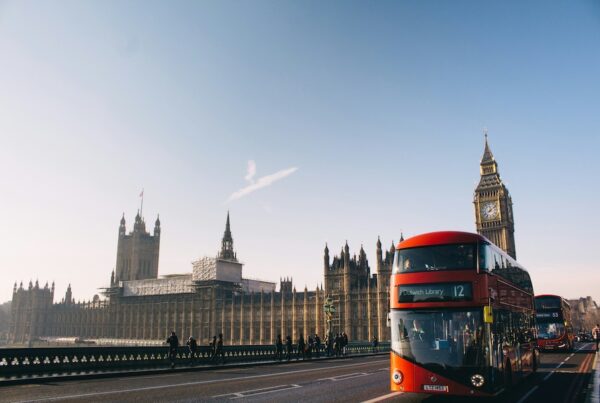
Recently visited London, and when I returned my oyster card, they even refunded me the remaining balance on the card.
Leave a Reply Cancel Reply
Save my name, email, and website in this browser for the next time I comment.
This site uses Akismet to reduce spam. Learn how your comment data is processed .
We’re Hiring
Become an Affiliate
Our Mission
Privacy Policy

Hi I’m Jess, the founder of Love and London. My team of locals and I help London tourists avoid the overhyped and overdone, so they can have the trip of a lifetime.
- London Itineraries
- Casual Tourist Guides to London
- London Spending Guide
- Free London 101 Guide
- Free London Trip Checklist
- London Packing Guide
- London Planning Tips
- Find Your Perfect Accommodation
- London Area Guides
- London Food + Drink Scene
- Things to Do in London
- Top London Tours and Experiences
- London Transport
- London with Kids
- Accessibility in London
- Festive Season Guides
- London Photo Sessions
- Book your airport transfer
- London FAQs
- Work with Love and London
- How To Say “Thanks”
- Press + Features

What is an Oyster Card? Whether You Should Get One & How to Use it
By: Author Tracy Collins
Posted on Last updated: September 22, 2023
If you’re planning a trip to London, then it’s pretty likely that you’ve heard of the Oyster Card. Getting around the UK capital by public transport is the best way to explore the city, and you will need some sort of travel card to access the tube, buses or trains.
This guide will answer all your questions – including, of course, what is an Oyster Card for London. Also covered is where to purchase one and how to use it. By the end of this article, you should know whether or not this is the right option to go for.
The Transport for London Oyster Card can be a smart way to travel. Here’s all you should know before buying one, including the available types, how and where to buy them and a whole host of frequently asked questions about this London travelcard.
What is an Oyster Card?
What does the oyster card cover, standard oyster card, visitor oyster card, children’s oyster card, the oyster card minimum balance, the oyster card maximum fare, buying an oyster card online, buying the london pass and oyster card, buying an oyster card in person, how to use the london oyster card, what is an oyster card and how does it work, what is the point of an oyster card, how much does it cost to buy an oyster card, is it cheaper to use an oyster card, what about visitor oyster card discounts, what is an oyster card – will you be buying one, london travel guide & itinerary planner (+ 4 bonus ebooks).

The Oyster Card. What is it? What does an Oyster Card do?
An Oyster Card is the size of a credit card. It’s a smartcard that is used to pay for trips on London Transport. This includes the tube network that dates from Victorian times and those cute red London buses. You can’t really say you’ve been to London without experiencing both of those!
Your Oyster Card can be topped up so it’s ready for use. This saves you time as opposed to buying separate tickets. It can also save you a lot of money. Some London Underground Oyster card fares, for instance, are less than half the price you’d pay for an individual ticket. That’s a considerable saving.
The Oyster Card allows you to pay as you travel by London Transport.
This includes tubes, buses, the DLR, trams, most overground trains, the rapid transit Elizabeth Line, Thames Clipper boats and even the IFS Cloud cablecar.
You can also use it to pay for train journeys between Gatwick Airport and the city, or to take the tube between the city and Heathrow Airport .
If you haven’t been to the British capital before, one thing to know is that the city is divided into zones. Travel fares are then calculated accordingly. A Visitor Oyster Card can be used in all 9 zones, though many residents and tourists never stray far beyond the more central areas.
A clever feature of the Oyster Card is that it will calculate the lowest available fare for each journey you make.
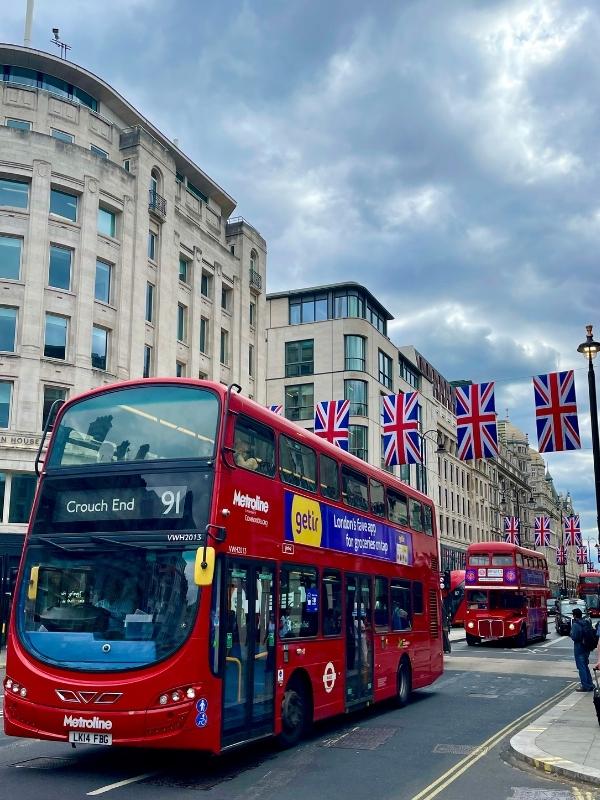
Types of Oyster Card
So when you’re asking what travelcard do I need, it’s a good idea to understand the kinds of Oyster Cards you can buy.
There are two main types of Oyster Card in the UK. There’s the standard version that residents tend to use, or the Visitor Oyster Card . An Oyster Card for children also gives them a considerable discount on travel.
Both the standard and visitor Oyster Cards for London costs £5 to buy and activate. The key difference to be aware of is that a regular Oyster Card can be loaded with a London travelcard, and a visitor one cannot. You’ll also pay postage on a visitor card.
If you’re staying a while, this could mean saving money. A 7-day travelcard, for example, can be great value for money if you’ll do a lot of travelling during a week’s stay. Here’s a quick reference guide to the key differences.
- Target market : London residents
- Design: Plain blue
- Activation fee: £5
- Travelcard compatible: Yes
- Registration required: Yes
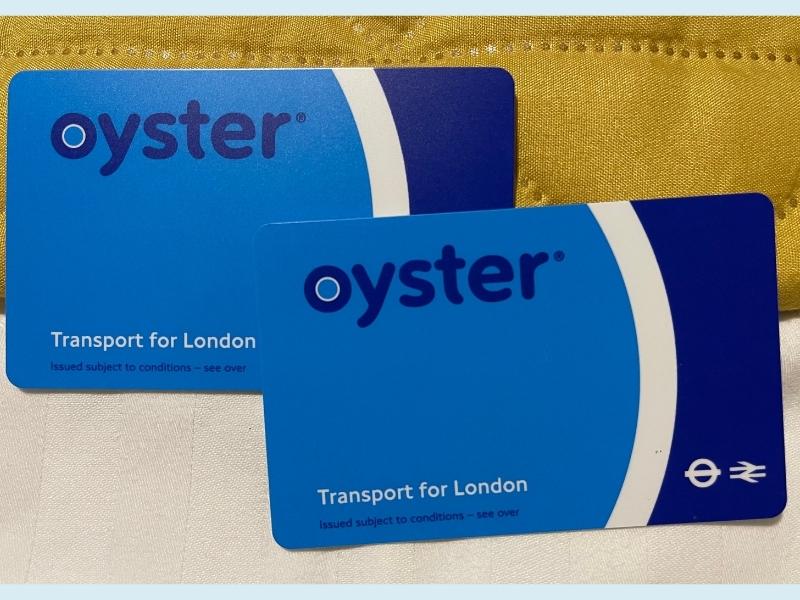
- Target market: Visitors to London
- Design : Multicoloured
- Activation fee: £5 (+ postage)
- Travelcard compatible : No
- Registration required: No
If your child is aged 11 or less, then they don’t need to pay for travel when they’re with a fare-paying adult. Up to four under-11s per adult can travel for free on buses, tubes, trams, the DLR, the Elizabeth line, London Overground services, and selected National Rail services.
For kids over 11, TfL advises buying a Visitor Oyster Card. Once you arrive in London, a Young Visitor discount can be applied at a tube station, visitor centre or the National Rail ticket office at Victoria train station. This discount gives them 50% off the adult fare for up to a fortnight.
So what’s the minimum Oyster top up?
You can add any amount between £10 and £50, increasing in £5 increments. £10, £15, £20, £25, £30, £35, £40 or £50 can therefore be added to your card. This top-up never expires, so it’s good for future visits too.
Even TfL themselves suggest letting your friends and family use your Oyster Card for their trips to the capital too!

One very interesting thing to know about the British Oyster Card is that your daily fares are capped. This cap limits the cost of every journey per day or week.
Once you reach a set limit – the cap – you will no longer be charged for any additional travel. Different price caps apply depending on whether you travel at peak or off-peak times. The caps that apply to bus and tram journeys versus other forms of London Transport also vary.
Transport for London says that capping is more cost-effective than a one-day travelcard when you make a few train trips per day. The same applies with the Oyster maximum fare when you use a combination of bus, tram and rail journeys during the day.
Always touch in and out with your Oyster Card when making your journeys, otherwise you could be charged the full fare for that trip! You should also use the same card or device each time for the fare cap to be applied.
Find out more about Oyster Card capping on the TfL website .
How to get an Oyster Card
There are three main options for those wondering how and where to buy an Oyster Card. You can order one online, get one as part of the London Pass or buy one in person.
If you want to buy an Oyster Card to be sent to an address outside the UK, you’ll need to get a Visitor Oyster Card. Standard cards can only be posted to a UK address.
You can buy your standard or Visitor Oyster Card directly from TfL.
Those who buy the London Pass can opt to add an Oyster Card to it. This is a pass for a duration of between one and seven days, increasing in daily increments. There is also a 10-day version.
The London Pass gives the holder access to over 80 London attractions, including Thames river cruises, London bike hire and hop-on hop-off bus routes. With key sights such as the Tower of London , Greenwich Observatory and London Zoo covered, it can be a very worthwhile purchase!
Find out more about the London Pass .
The final option is to buy an Oyster Card when you arrive. You may only be able to obtain a standard one this way, however: the sale of visitor cards is limited. They’re sold only via certain tourist offices, overseas travel agencies, on board a London-bound Eurostar train and at some London airports.
You can buy standard Oyster Cards once you’re in the city from tube station ticket machines, train stations, London Visitor Centres and Oyster ticket stops.
Top-ups can be purchased at the same places.
You need to use your Oyster Card at the beginning and end of each journey unless it’s made on a tram or bus. Otherwise, London Transport cannot calculate the correct fare to charge to your card.
There are yellow card readers to use for this purpose. Don’t touch out when you alight from a bus or tram. For tubes, trains and other forms of transport, it’s important to use the same card or device each time.
If there are no gates – or these are open – you still need to touch in or out on a yellow card reader at the station.
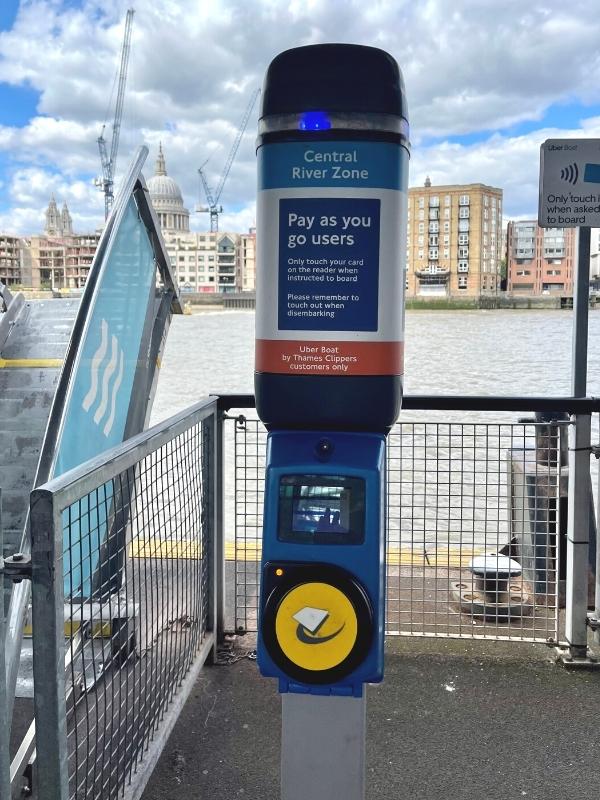
The London Oyster Card – FAQs
An Oyster Card is a smart travelcard that you pre-load with top-ups. This money is then deducted from the card when you travel by London Transport.
The Oyster Card can be used to pay for trips on buses, tubes, mainline trains, trams, the DLR, the new Elizabeth Line, Thames Clippers and the IFS Cloud Cable Car.
An Oyster Card can save you time as well as money when travelling on London’s excellent public transport network. It’s a simple and effective way to pay as you go for the trips you make.
A price cap means that once you travel more than a certain amount, the rest of your travel during that period is free. If you’ll travel a lot in London, then it’s probably worth getting an Oyster Card.
So how much is an Oyster Card? The visitor or standard Oyster Card costs £5. There is also a postage fee for visitor cards.
Once you’ve paid for the card, it can be topped up with between £10 and £50 worth of credit, rising in increments of £5. This never expires.
Transport for London recommends pre-loading your Oyster Card with around £7.50 per day that you’ll use it. Whether this works out cheaper for you depends on precisely how many journeys you’d make during each day and the destinations you’re travelling between.
Compare your options by using TfL’s Single Fare Finder or checking out Travelcard prices and Oyster Card caps .
A Visitor Oyster card gives you access to exclusive discounts and special offers in London. You could save cash when shopping or dining out, and at entertainment venues. Visitor Oyster Card discounts also apply to the IFS Cloud cable car.
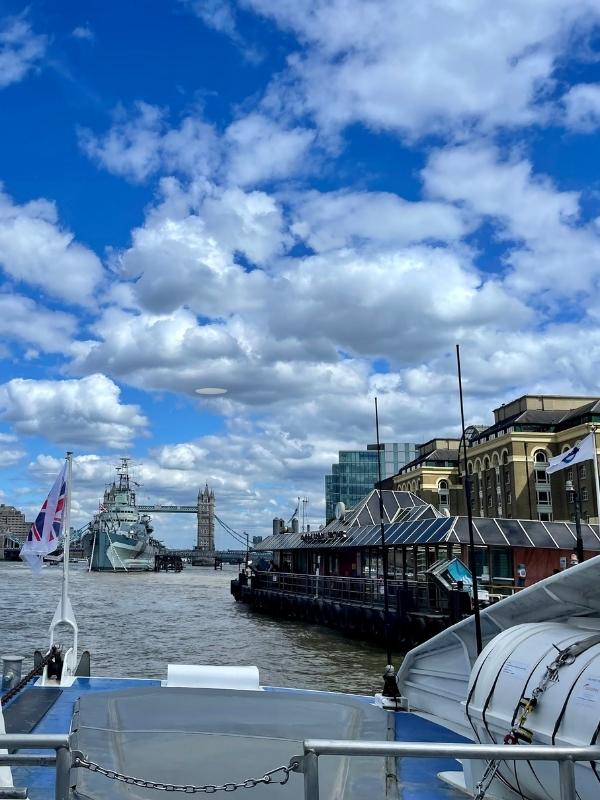
We love the Oyster Card maximum daily fare feature when visiting London. Using the card also saved us time as well as money while exploring London.
As long as you’ll recoup the initial £5 fee and make enough journeys for it to be worthwhile, the Oyster Card maximum daily cost means it’s likely to save you cash. To make sure, simply compare the single fares or travelcard costs for journeys you’re likely to make (via the links given above) before taking the plunge!
While you’re here, don’t miss our awesome guide to Getting Around London . You can also check out the complete London Travel Guide here .
Enjoy podcasts? Listen to our podcast episode in which I share top tips and information for first-time visitors to London.
- London Travel Guide – links to everything you need to know to plan your trip
- Looking for accommodation? Read our guide to where to stay in London
- First time visitors? Read our top tips for visiting London for the first time
- How to get around London? Read our guide to using public transport in London and our guide to London’s manin trains stations.
- What to see and do – Complete London bucket list with guide to all the top sights and attractions & Guide to the Changing of the Guard at Buckingham Palace
- How to purchase tickets for London attractions – Guide to purchasing tickets for the lost popular London attractions & Best London bus tours reviewed
- Boat trips and cruises – Comparison guide to the best boat trips and cruises on the Thames
- Visiting on a budget? Read out budget guide to London with tips to save money when visiting
- Free things to do in London – Discover 32 free things to see and do in London
- Best day trips? Read our guide to the best day trips by train and ou r guide to the best tours from London
- Love castles? Our guide to the most popular castles to visit from London
- Beatles fan? Read our guide to the Beatles in London


IMAGES
VIDEO
COMMENTS
You will still be able to top up and manage your Oyster card via the Oyster and Contactless app, Ticket Stops or ticket machines across the network. You can continue to use your Oyster card for travel. The Oyster part of your online account and TfL's Oyster customer service line will be available from 08:00 on Saturday 27 April. Home.
Visitor Oyster cards, Oyster cards and contactless payment cards are the cheapest way to travel in London. To use an Oyster card, touch the card on the yellow reader at the gates as you enter and end your journey. You don't need to touch out at the end of your journey on buses and trams. You can buy a Visitor Oyster card online before you ...
The cheapest one-day travelcard for costs £15.20. This is the price of the 1-day travel card for zone 1, zones 1-2, 1-3 and 1-4. The maximum daily cap when using an oyster in zones 1 and 2 of London is £8.10, £9.60 for zones 1-3 and £11.70 for zones 1-4.
Using an Oyster card with a 7 day Travelcard loaded onto the Oyster card. Most visitors will just travel in the central zones, 1 and 2. If you are staying more than 5 days in Central London then a 7 day Travelcard zone 1-2 is probably going to be cheaper than just an Oyster card.
So you get 12 months travel for the price of 10½. Alternatively they give a 23% saving compared with continuing use of 7 Day Travelcards, meaning you get 52 weeks for the price of 40. Note that with pay as you go on Contactless or Oyster, Monday to Sunday capping, like 7 Day Travelcards, can give you seven days' travel for the price of five days.
An Oyster card may be the most cost-effective option if you are only visiting for a few days. A 7 Day Travelcard is a good option if you are visiting for a week and only plan to visit central London. You can also use contactless payment, which has both a daily and weekly fare cap. This may work out cheaper than a Travelcard.
Use an Oyster card to pay as you go to travel on our transport. Contactless and Oyster account. Get an account to manage your travel quickly and easily. TfL Oyster and contactless app . Top up anytime, anywhere and manage your cards on the go. Protecting your accounts .
An Oyster card or a Visitor Oyster card* is a travel smartcard which you can use to pay for journeys on public transport in London, including the bus, Tube, Docklands Light Railway (DLR), tram, Uber Boat by Thames Clippers river bus, London Overground and most National Rail services in London.
Children under 11 travel for free and there is a 50% discount on Oyster Card fares for children 11-15 years of age with the Young Visitor Oyster Discount. To receive this discount, you need to speak to a Tube staff member at any Underground station, including Heathrow, or you can purchase it on the automatic machines in any station.
For example, if you load £10 onto your Oyster card and travel by underground in central London (zone 1- off peak): If you make 1 journey £2.70 is deducted from your card; If you make 2 journeys, £5.40 is deducted; If you make 3 journeys, £8.50 is deducted. You have now reached the 'daily cap' and all other journeys until 4.30am the ...
The Oyster Card is the most recommended option for use to travel on London´s public transport. It is what Londoners tend to use on a daily basis for commuting, and it is normally the cheapest way for tourists to get around London. In this article we will explain what the Oyster card actually is, how it works and how to decide if it is the right option for you if you are planning a trip to London.
Oyster cards. An Oyster card is a smart card that you add money to, so you can pay as you go. You can pay as you go to travel on bus, Tube, tram, DLR, London Overground, most Elizabeth line, IFS Cloud Cable Car and Thames Clippers River Bus services. You can also travel on most National Rail services in London and some outside London.
Find out more about Oyster. Find out more about Oyster cards here. 7 day contactless journey and payment history. Access up to 7 days history without an account. Fares. Find out how much it costs and how to pay for travel around London. Toggle Navigation Skip page navigation Contactless and Oyster Contactless. 7 day journey & payment history
Using a Pay as you go Oyster card or a contactless card are the cheapest ways to pay for travel if you're in London for 1-5 days. The daily cap is £8.50 per day for zones 1-2. If you really don't want to use an Oyster card or don't have a contactless card, the One Day Travelcard is the next best money-saving pass.
Regular Oyster Cards. For long-term visitors, a regular Oyster card could be the more cost-effective option. These cards can only be purchased upon arrival, from Oyster Ticket Shops, Visitor Centers and most London Tube and rail stations. They cost £5 ( refundable at the end of your trip) and can be loaded with any amount of pay-as-you-go credit.
The biggest benefit of using an Oyster card is its joint cheapest fares for single journeys (along with contactless) The Oyster daily cap is always cheaper than buying a 1-day travelcard. Oyster pay-as-you-go credit can be used in zones 1-9, whereas travelcards are only valid in the zones you buy them for.
Both types of Oyster Cards get charged more for peak travel, so you pay more to travel on the Tube, DLR, London Overground, TfL Rail and National Rail services in London 6:30-9:30 AM and 4 - 7 PM, Monday through Friday. Peak doesn't apply for bus fares.
Oyster cards aren't accepted at stations between Reading and Iver. Refunds. If you got your Oyster card before 23 February 2020, you can get your £5 refunded when you don't need your card anymore; If you got your Oyster card between 23 February 2020 and 4 September 2022, your £5 will be refunded automatically as pay as you go credit after one ...
An Oyster Card is a smart travelcard that you pre-load with top-ups. This money is then deducted from the card when you travel by London Transport. The Oyster Card can be used to pay for trips on buses, tubes, mainline trains, trams, the DLR, the new Elizabeth Line, Thames Clippers and the IFS Cloud Cable Car.
The Oyster card is a payment method for public transport in London (and certain areas around it) in England, United Kingdom.A standard Oyster card is a blue credit-card-sized stored-value contactless smart card. It is promoted by Transport for London (TfL) and can be used on travel modes across London including London Buses, London Underground, the Docklands Light Railway (DLR), London ...
Covers Travelcards and Cap fares for Tube, DLR, London Overground, Elizabeth line and most National Rail services.
The Oyster Card can be purchased when you arrive from ticket offices or kiosks at the train and tube stations, or even onboard Eurostar trains bound for London. A £7 non-refundable fee applies. Non-residents have the option to get the Visitor Oyster Card (with a £5 non-refundable fee). The Visitor Oyster can only be ordered online.